Inside this Article
What Is “Sales”?
Before we get into our massive list of sales statistics, it’s probably best to clear up a couple of definitions first. Sales is an industry full of jargon, after all. What is “Sales”? By definition, a “sale” describes the transaction of goods, commodities, or services between one party and another in exchange for money. “Sales,” then, is the line of work that procures transactions for businesses. “Sales” refers to all activities involved in selling a company’s products/services to customers or clients. Businesses usually have a sales team responsible for all of this stuff. Still with me? Good, because there’s more! Sales can be broken into several different definitions, as there are multiple different types of selling. We’ve defined the essential terms in the table below.| Term | Definition |
|---|---|
| Outside Sales | The sale of products/services by sales personnel outside the office who meet with prospective customers. Outside sales professionals often work autonomously, traveling to meet customers and maintain business relationships. |
| Inside Sales | Inside sales involve selling goods/services from an office setting, either via phone, email, or online. Inside sales professionals do not leave the office. |
| Retail Sales | Retail sales capture customer sales by delivering the best customer experience through monitoring demand for goods and purchasing behaviors. |
| Direct Sales | A sales method where the seller personally engages a potential buyer in a face-to-face interaction outside of a retail environment. Direct-sellers often work on their own, receiving a commission for the products they sell. |
| Online Sales | The sale of products through the internet or online channels. Online sales could occur through an eCommerce website or a mobile app. |
| Social Sales | The process of connecting and engaging with “leads” (potential buyers) through social media platforms. Think of social sales as a form of relationship building, not to be confused with social media marketing. |
| Cold Calling | An unsolicited phone call from the seller to another business or person in an attempt to sell goods/services — a form of prospecting. |
| Prospecting | The process of accumulating leads through networking, cold calling, and advertising, along with various other methods. |
| Sales Lead | A sales lead (or a “lead”) is any person, company, or organization that could potentially become a client in the future. |
| Cold Lead | A lead that has never expressed any interest in a company’s product/service. |
| Warm Lead | A lead that has shown interest in a company’s product/service and wants to know more information. |
| Hot Lead | A lead that is highly interested in a company’s product/service. Hot leads are engaged with the selling business and are most likely to make a purchase. |
Sales Industry Overview
We’ll start by giving you an overview of the sales world. How big is the sales market? Why are sales important? And how often do sales teams get the deal over the line?1. Total Retail Sales
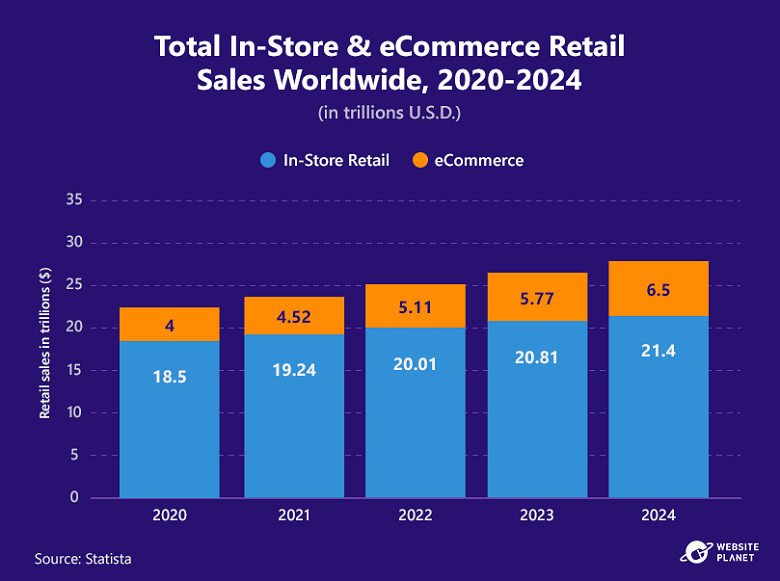 Retail sales are the biggest market for sales and involve the sale of goods to the public. This could be through a retail store or eCommerce store and is different from B2B sales, which involves transactions between business suppliers and business buyers.
Retail sales are forecasted to see exponential growth in the next few years, reaching an extraordinary total market size of nearly $28 trillion by 2024. This growth is fueled by a rising global population and an increasing consumer demand.
In-store retail will grow from $19.24 trillion to $21.4 trillion in 2024, but the key growth area is online retail. Online retail will swell 62.5% between 2020 and 2024, rising from $4bn to $6.5bn.
Retail sales are the biggest market for sales and involve the sale of goods to the public. This could be through a retail store or eCommerce store and is different from B2B sales, which involves transactions between business suppliers and business buyers.
Retail sales are forecasted to see exponential growth in the next few years, reaching an extraordinary total market size of nearly $28 trillion by 2024. This growth is fueled by a rising global population and an increasing consumer demand.
In-store retail will grow from $19.24 trillion to $21.4 trillion in 2024, but the key growth area is online retail. Online retail will swell 62.5% between 2020 and 2024, rising from $4bn to $6.5bn.
2. Online Sales Revenue Growth
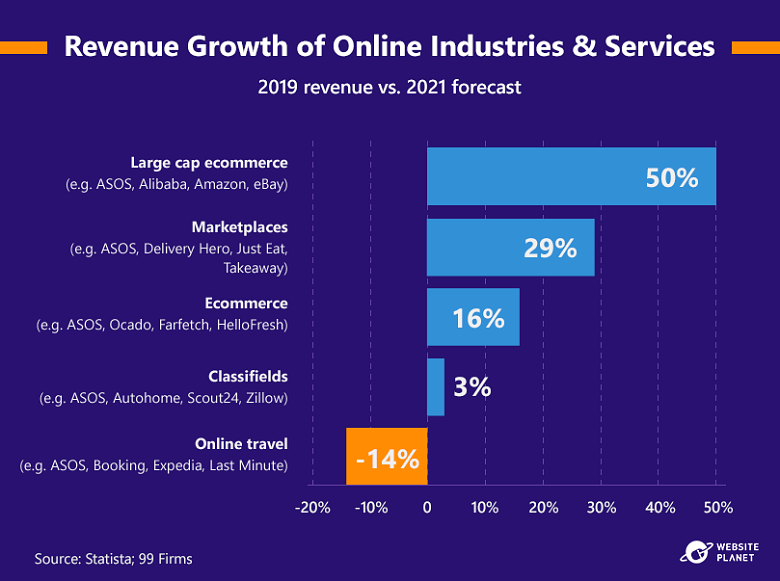 In keeping with retail statistics, online services across the board will continue to grow for years to come.
eCommerce will see the most considerable revenue growth. Indeed, eCommerce has already snowballed over the last 2 years. A period that saw Jeff Bezos accumulate $75 billion before announcing he was stepping down as Amazon’s CEO.
Online marketplaces and other eCommerce sites will see significant growth too. So far, the projections are holding true. In the United Kingdom, online sales accounted for 35.2% of all sales in January 2021 — a national record. That figure increased from 29.6% in December 2020 and 19.5% in January 2020.
The cause? The COVID-19 pandemic, of course, forced many people online as high-street doors slammed shut. The pandemic affected direct sales as well.
In keeping with retail statistics, online services across the board will continue to grow for years to come.
eCommerce will see the most considerable revenue growth. Indeed, eCommerce has already snowballed over the last 2 years. A period that saw Jeff Bezos accumulate $75 billion before announcing he was stepping down as Amazon’s CEO.
Online marketplaces and other eCommerce sites will see significant growth too. So far, the projections are holding true. In the United Kingdom, online sales accounted for 35.2% of all sales in January 2021 — a national record. That figure increased from 29.6% in December 2020 and 19.5% in January 2020.
The cause? The COVID-19 pandemic, of course, forced many people online as high-street doors slammed shut. The pandemic affected direct sales as well.
3. Direct Sales Are Diminishing
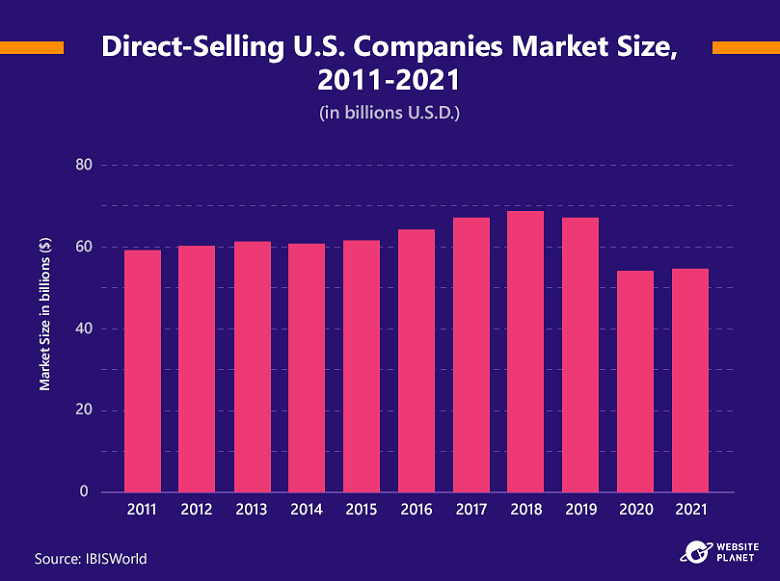 Direct sales are at odds with brick-and-mortar retail methods, as some companies choose to sell their products directly to consumers rather than in-store.
In many people’s eyes, some areas of the practice are outdated. Gone are the days of fraudulent pyramid schemes and aggressive door-to-door sales tactics (think, Kirby’s infamous hoover sales methods of the 90s).
While in-store retail expects to bounce back from COVID-19, on the other side of the coin is direct-selling, which looks set to suffer as a result.
Customer concerns about one-to-one contact have damaged the direct sales market. Direct sales grew 1.2% in 2021, reaching $55bn, though the industry has shrunk, on average, 3.1% every year between 2016 and 2021.
Direct sales are at odds with brick-and-mortar retail methods, as some companies choose to sell their products directly to consumers rather than in-store.
In many people’s eyes, some areas of the practice are outdated. Gone are the days of fraudulent pyramid schemes and aggressive door-to-door sales tactics (think, Kirby’s infamous hoover sales methods of the 90s).
While in-store retail expects to bounce back from COVID-19, on the other side of the coin is direct-selling, which looks set to suffer as a result.
Customer concerns about one-to-one contact have damaged the direct sales market. Direct sales grew 1.2% in 2021, reaching $55bn, though the industry has shrunk, on average, 3.1% every year between 2016 and 2021.
4. A Changing B2B Market
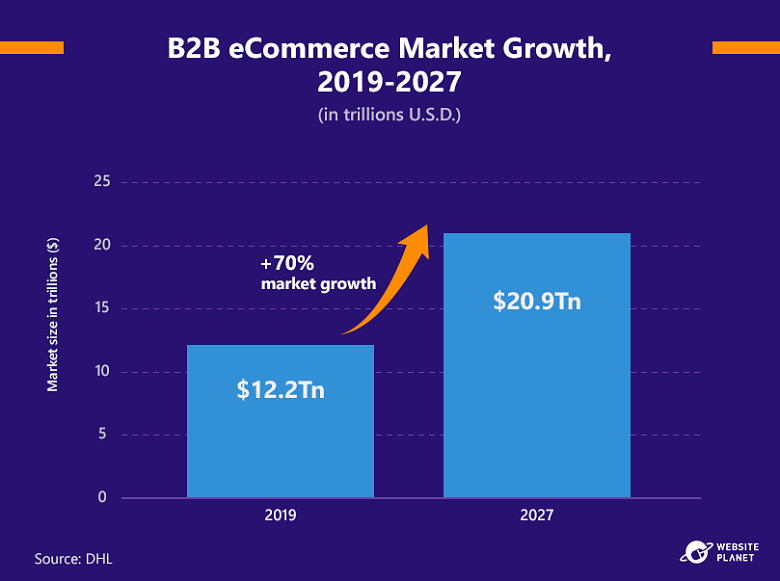 Traditionally, B2B businesses interact with customers face-to-face. But the pressures of a pandemic alongside continued online growth are leading to a considerable eCommerce uptake in B2B.
80% of B2B sales between suppliers and business buyers will take place online by 2025.
B2B businesses are already using digital methods with increasing regularity, out of necessity more than anything else. eCommerce and video conferencing accounted for 43% of the average B2B company’s revenue during the pandemic (Mckinsey).
Traditionally, B2B businesses interact with customers face-to-face. But the pressures of a pandemic alongside continued online growth are leading to a considerable eCommerce uptake in B2B.
80% of B2B sales between suppliers and business buyers will take place online by 2025.
B2B businesses are already using digital methods with increasing regularity, out of necessity more than anything else. eCommerce and video conferencing accounted for 43% of the average B2B company’s revenue during the pandemic (Mckinsey).
5. Sales Is Still A Popular Profession
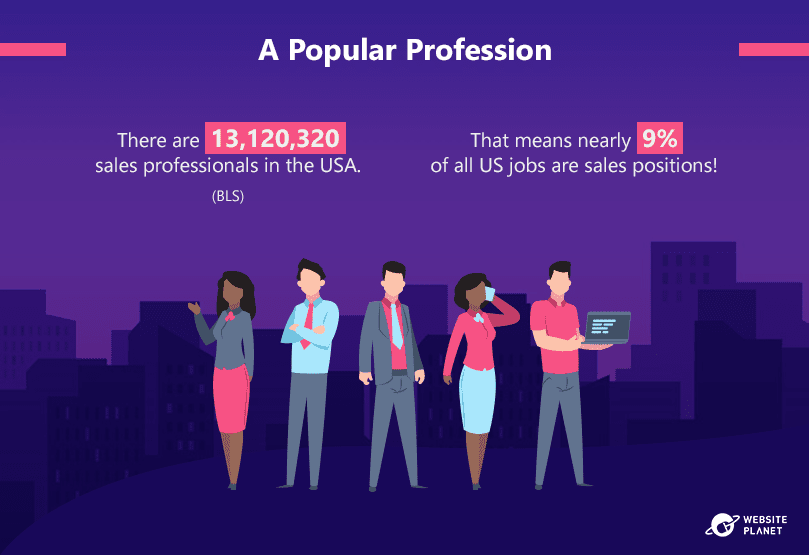 Sales professionals are all around us. In a capitalist society, money is essential, and sales professionals make a lot of it for their respective companies.
A huge portion of the U.S. workforce is in sales positions, owing to the practice’s popularity. Collectively, businesses spend more than $1 trillion on sales teams every single year.
Sales professionals are all around us. In a capitalist society, money is essential, and sales professionals make a lot of it for their respective companies.
A huge portion of the U.S. workforce is in sales positions, owing to the practice’s popularity. Collectively, businesses spend more than $1 trillion on sales teams every single year.
6. There’s Value in Sales
 B2B customers find value when speaking to a sales professional. “Value” is the keyword here. Sales teams should aid the sales process, not hinder it. Presenting helpful information and generally improving the customer’s experience is considered the best way to boost sales.
B2B customers find value when speaking to a sales professional. “Value” is the keyword here. Sales teams should aid the sales process, not hinder it. Presenting helpful information and generally improving the customer’s experience is considered the best way to boost sales.
7. Businesses Need Sales
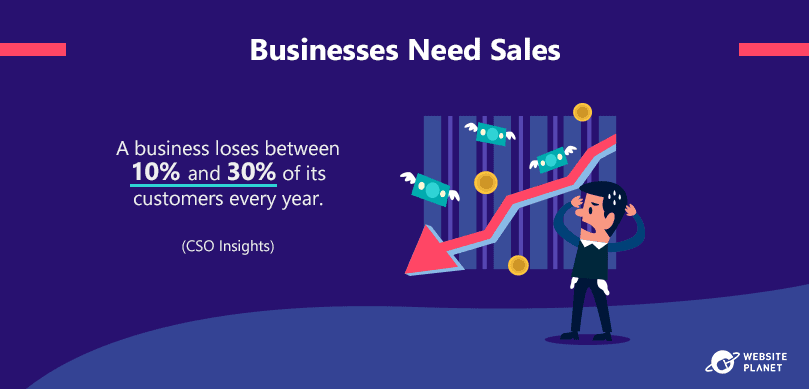 In a free market, companies can expect to lose a fair portion of their business every year. That’s why sales teams are so important. They can improve customer retention by maintaining existing relationships, while adding more customers to ensure businesses are growing (not shrinking).
In a free market, companies can expect to lose a fair portion of their business every year. That’s why sales teams are so important. They can improve customer retention by maintaining existing relationships, while adding more customers to ensure businesses are growing (not shrinking).
8. Most Buyers Are Warm
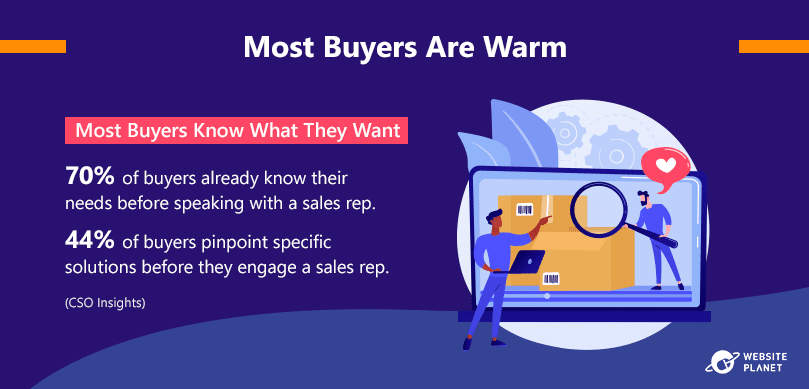 The sales profession is not simply about prospecting cold leads for a business. Many customers already know what they want, and they may already know quite a lot about the product/business before engaging with a sales representative.
Sometimes customers just need a little bit of extra help to get the deal over the line. “Pushy” sales tactics are outdated when customers can form their own ideas through a catalog of content marketing materials.
The sales profession is not simply about prospecting cold leads for a business. Many customers already know what they want, and they may already know quite a lot about the product/business before engaging with a sales representative.
Sometimes customers just need a little bit of extra help to get the deal over the line. “Pushy” sales tactics are outdated when customers can form their own ideas through a catalog of content marketing materials.
9. Top-Performers Dominate
 The cream rises to the top in sales. The very best sales professionals are dominant, pulling in most of their company’s deals and revenue.
Sales professionals rely on charisma and human interaction to get the job done. Not many people have the skills to be a top salesperson, which explains our next fact.
The cream rises to the top in sales. The very best sales professionals are dominant, pulling in most of their company’s deals and revenue.
Sales professionals rely on charisma and human interaction to get the job done. Not many people have the skills to be a top salesperson, which explains our next fact.
10. Most Sales Pros Aren’t Good
 Most sales professionals are pretty bad at the job. Another reason why just 13% of customers believe sales professionals can understand their wants and needs (Brevet).
There are good reasons behind this. Staff turnover in sales positions is significant, with many sales reps using the profession to fill a gap in their CV.
The average rep stays in the job for a meager 18 months, while committed reps can expect a promotion to account manager anywhere from 13-18 months.
Most sales professionals are pretty bad at the job. Another reason why just 13% of customers believe sales professionals can understand their wants and needs (Brevet).
There are good reasons behind this. Staff turnover in sales positions is significant, with many sales reps using the profession to fill a gap in their CV.
The average rep stays in the job for a meager 18 months, while committed reps can expect a promotion to account manager anywhere from 13-18 months.
11. Inside vs. Outside Closing Rates
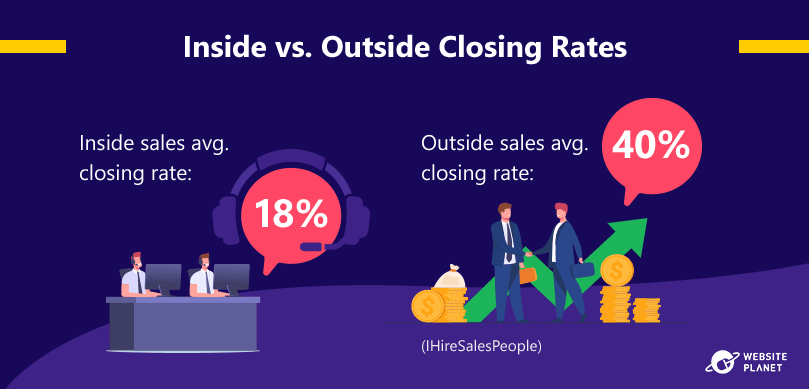 Inside sales professionals have a much lower closing rate when compared to outside sales professionals.
The “closing rate” measures the success of a sales team. It demonstrates the rate at which qualified leads convert into sales (i.e., the success rate of all formal quotes sent by the sales team).
Outside sales reps manage longer, more complex deals. Their customers are often more invested in the deal, meeting sales reps face-to-face. As a result, outside reps have higher close rates.
Inside reps never actually meet the customer/client, and deals are often smaller and less significant. Thus, close rates are lower for inside reps.
Inside sales professionals have a much lower closing rate when compared to outside sales professionals.
The “closing rate” measures the success of a sales team. It demonstrates the rate at which qualified leads convert into sales (i.e., the success rate of all formal quotes sent by the sales team).
Outside sales reps manage longer, more complex deals. Their customers are often more invested in the deal, meeting sales reps face-to-face. As a result, outside reps have higher close rates.
Inside reps never actually meet the customer/client, and deals are often smaller and less significant. Thus, close rates are lower for inside reps.
12. Closing Rates by Industry
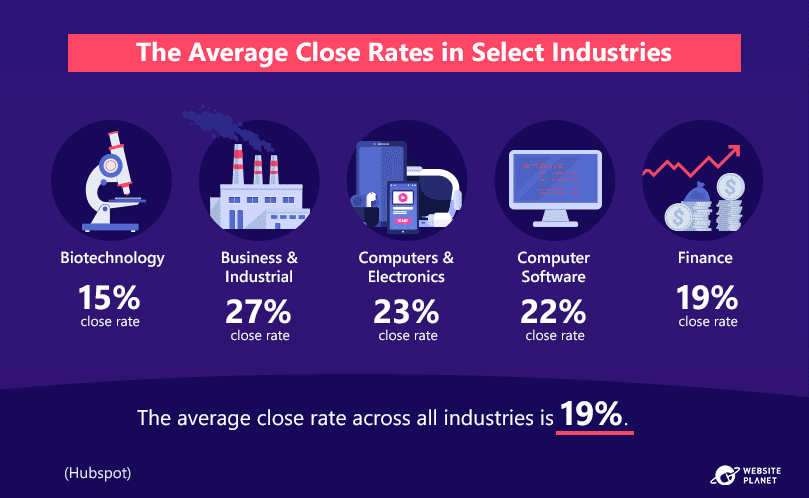 Here are some close rates for top industries. The business & industrial sector has a high close rate of 27%.
The electronics and software industries have similar close rates, at 22% and 23% respectively, while finance has a close rate of 19%.
The lowest industry close rate on Hubspot’s list is biotechnology, which has a 15% close rate. The average close rate across all industries is 19%.
Here are some close rates for top industries. The business & industrial sector has a high close rate of 27%.
The electronics and software industries have similar close rates, at 22% and 23% respectively, while finance has a close rate of 19%.
The lowest industry close rate on Hubspot’s list is biotechnology, which has a 15% close rate. The average close rate across all industries is 19%.
13. Closed Deals Are Increasing
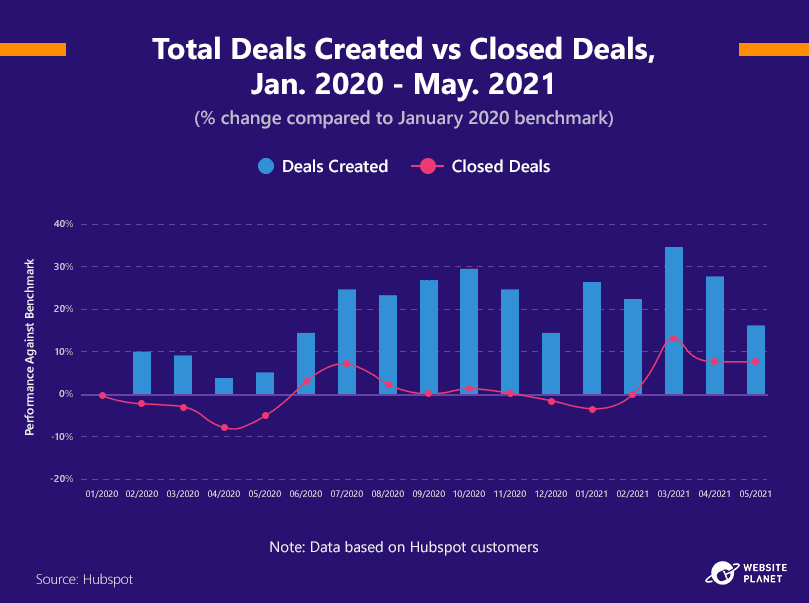 How has COVID-19 affected the number of closed deals? Compared to a January 2020 baseline, closed deals dropped for the first 6 months of 2020 before returning to normal levels ever since.
Industries like media and recruitment suffered the most during the first half of 2020. Recruitment, in particular, saw a 30% drop in the number of closed deals.
Companies have been making up for lost time as the economy has steadily reopened. Late 2020 saw almost 30% more deals being created in some months, while early 2021also demonstrated a significant rise in the number of created deals and closed deals.
How has COVID-19 affected the number of closed deals? Compared to a January 2020 baseline, closed deals dropped for the first 6 months of 2020 before returning to normal levels ever since.
Industries like media and recruitment suffered the most during the first half of 2020. Recruitment, in particular, saw a 30% drop in the number of closed deals.
Companies have been making up for lost time as the economy has steadily reopened. Late 2020 saw almost 30% more deals being created in some months, while early 2021also demonstrated a significant rise in the number of created deals and closed deals.
14. Conversion Rate by Industry
 “Conversion rate” measures the success of eCommerce sales efforts. It is the number of “conversions” (sales) divided by the number of visitors.
Grocery stores convert at a higher rate than any other industry, which is unsurprising when we consider that users are often committed to a purchase before they visit a grocery store.
Apparel stores, travel sites, and beauty stores are also above the industry average conversion rate of 1.8%, falling from 2.49% in 2019.
Consumer electronics, luxury stores, and telecom companies all have lower conversion rates. These stores provide higher-value products which sell less often.
Contentsquare found that users accessing from a tablet have the highest conversion rate across all industries, with a 2.6% conversion rate compared to desktop (2.3%) and mobile (1.5%).
“Conversion rate” measures the success of eCommerce sales efforts. It is the number of “conversions” (sales) divided by the number of visitors.
Grocery stores convert at a higher rate than any other industry, which is unsurprising when we consider that users are often committed to a purchase before they visit a grocery store.
Apparel stores, travel sites, and beauty stores are also above the industry average conversion rate of 1.8%, falling from 2.49% in 2019.
Consumer electronics, luxury stores, and telecom companies all have lower conversion rates. These stores provide higher-value products which sell less often.
Contentsquare found that users accessing from a tablet have the highest conversion rate across all industries, with a 2.6% conversion rate compared to desktop (2.3%) and mobile (1.5%).
15. Which Industries Are Growing?
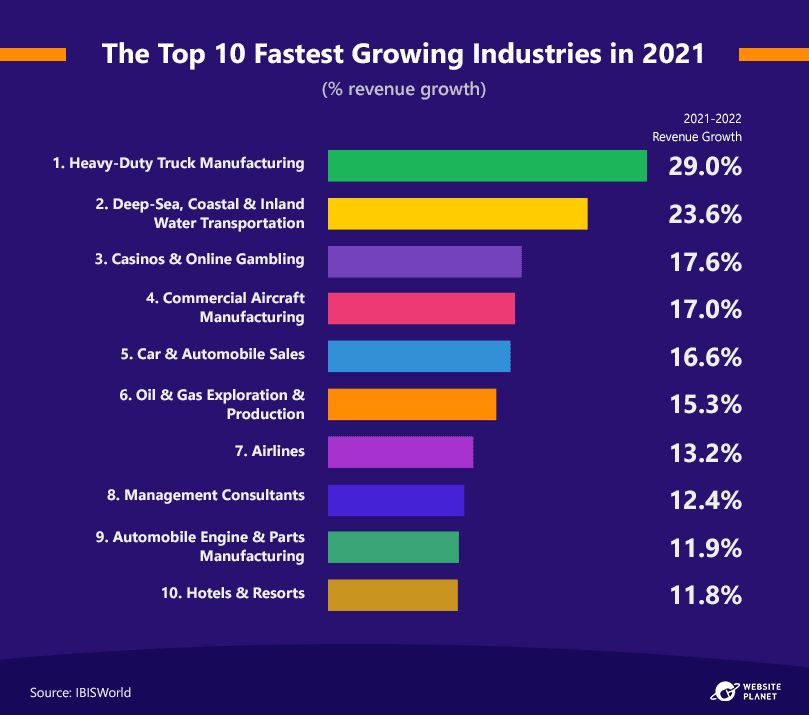 Some industries are faring better than others at this moment in time. Transportation sectors are seeing significant growth as lockdowns begin to ease, with airlines and coastal transportation among the fastest growing sectors.
Manufacturers are growing revenues, too, as a steady industry throughout the COVID-19 pandemic. Hospitality industries are another beneficiary of easing lockdown restrictions in some nations.
Some industries are faring better than others at this moment in time. Transportation sectors are seeing significant growth as lockdowns begin to ease, with airlines and coastal transportation among the fastest growing sectors.
Manufacturers are growing revenues, too, as a steady industry throughout the COVID-19 pandemic. Hospitality industries are another beneficiary of easing lockdown restrictions in some nations.
Salespeople Statistics
In this section, we’ll introduce ourselves to the average salesperson. We’ll be looking at the stats behind their life, work, and the ways they go about their daily business.16: Where Do Salespeople Work?
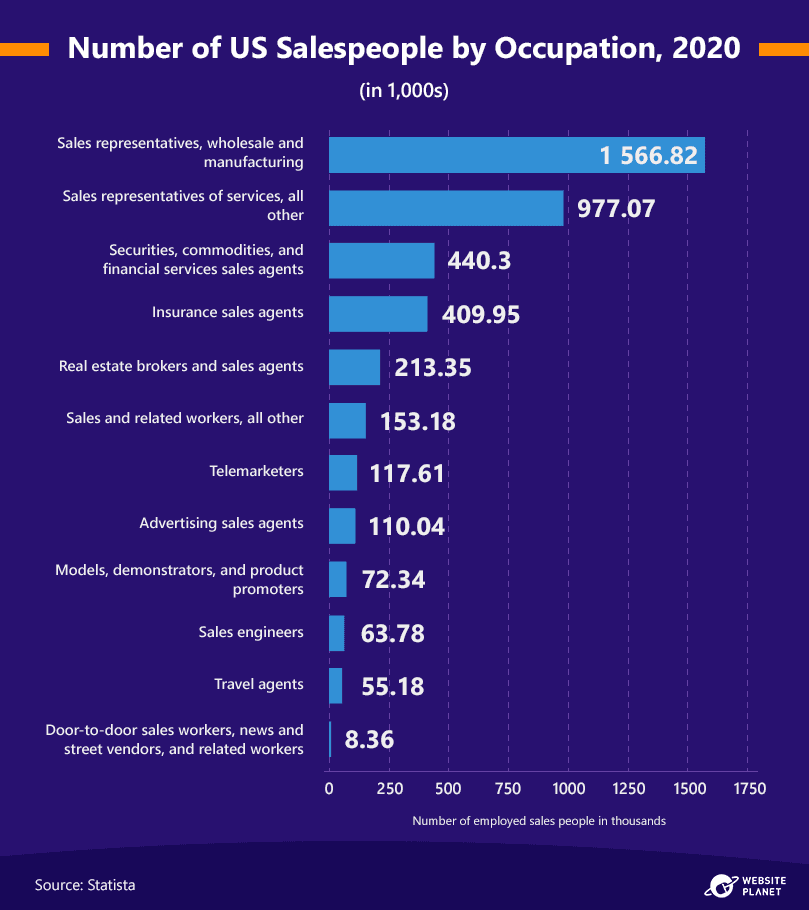 The above graph marks some of the most critical industries and occupations for sales.
With over 13 million total sales professionals in the US, sales teams have become integral across pretty much every sector. Sales reps in the wholesale and manufacturing sectors are most common in the US.
Sales reps of services are popular too, as are securities, commodities, and financial services sales agents.
The above graph marks some of the most critical industries and occupations for sales.
With over 13 million total sales professionals in the US, sales teams have become integral across pretty much every sector. Sales reps in the wholesale and manufacturing sectors are most common in the US.
Sales reps of services are popular too, as are securities, commodities, and financial services sales agents.
17. How Much Do Salespeople Earn?
 The average sales professional earns a healthy base salary of $60k per year. The very best sales pros differentiate themselves by meeting their sales targets and creating more business.
That’s why on-target sales pros stand to earn a lot more. The average on-target salesperson makes a whopping $118k. That’s no small change.
It’s also worth noting that outside sales pros earn around 14% more than inside sales pros on average (SalesLoft).
The average sales professional earns a healthy base salary of $60k per year. The very best sales pros differentiate themselves by meeting their sales targets and creating more business.
That’s why on-target sales pros stand to earn a lot more. The average on-target salesperson makes a whopping $118k. That’s no small change.
It’s also worth noting that outside sales pros earn around 14% more than inside sales pros on average (SalesLoft).
18. Salesperson Education
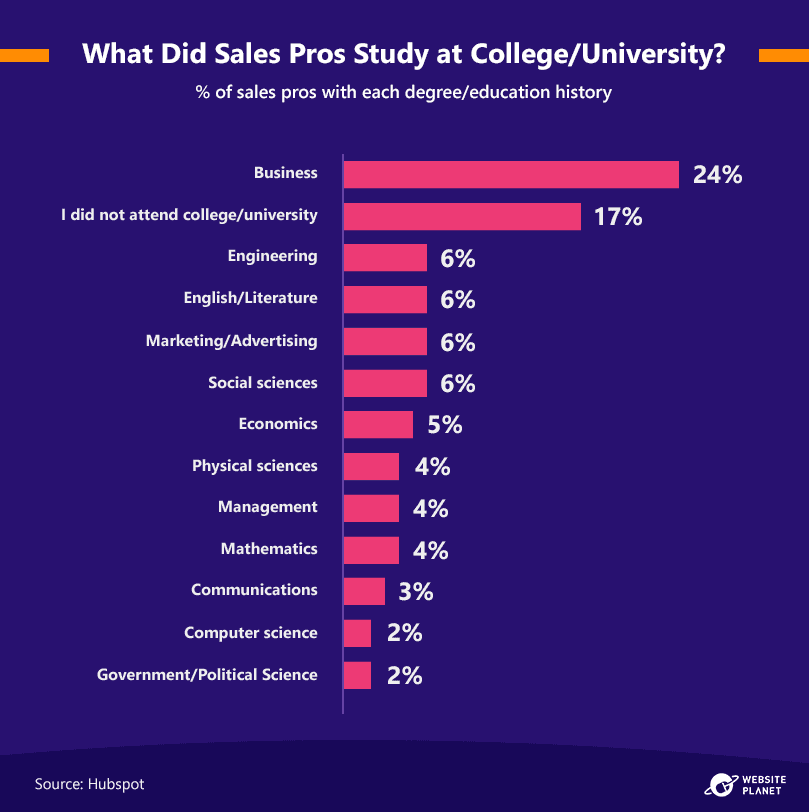 How educated are sales pros? A business degree is the major of choice, with 24% of sales pros holding a business degree.
A massive 17% of sales professionals do not have a degree at all. This demonstrates that hard work and experience count for a lot in the world of sales.
Engineering, English, and Marketing are 3 more common degrees among sales professionals, though the research ultimately shows that sales professionals can come from various educational backgrounds.
Your ability to succeed in the job is more important than anything else.
How educated are sales pros? A business degree is the major of choice, with 24% of sales pros holding a business degree.
A massive 17% of sales professionals do not have a degree at all. This demonstrates that hard work and experience count for a lot in the world of sales.
Engineering, English, and Marketing are 3 more common degrees among sales professionals, though the research ultimately shows that sales professionals can come from various educational backgrounds.
Your ability to succeed in the job is more important than anything else.
19. People Don’t Always Aim to Be In Sales
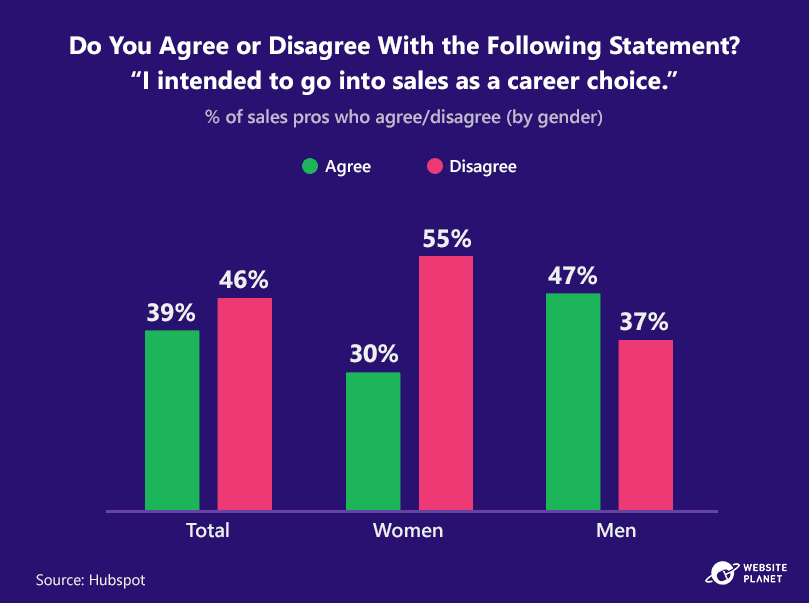 People don’t plan for a career in sales. 46% of the total sales workforce did not intend to get into the profession.
Sales is often a profession people stumble upon before discovering they can succeed if they work hard.
For some, it is a stopgap in their career. For others, sales is an opportunity to earn good money.
Female sales professionals are far less likely to plan for a career in sales than their male counterparts; 55% of women didn’t plan on working in sales, while 37% of men said the same.
People don’t plan for a career in sales. 46% of the total sales workforce did not intend to get into the profession.
Sales is often a profession people stumble upon before discovering they can succeed if they work hard.
For some, it is a stopgap in their career. For others, sales is an opportunity to earn good money.
Female sales professionals are far less likely to plan for a career in sales than their male counterparts; 55% of women didn’t plan on working in sales, while 37% of men said the same.
20. The Average Sales Work Week
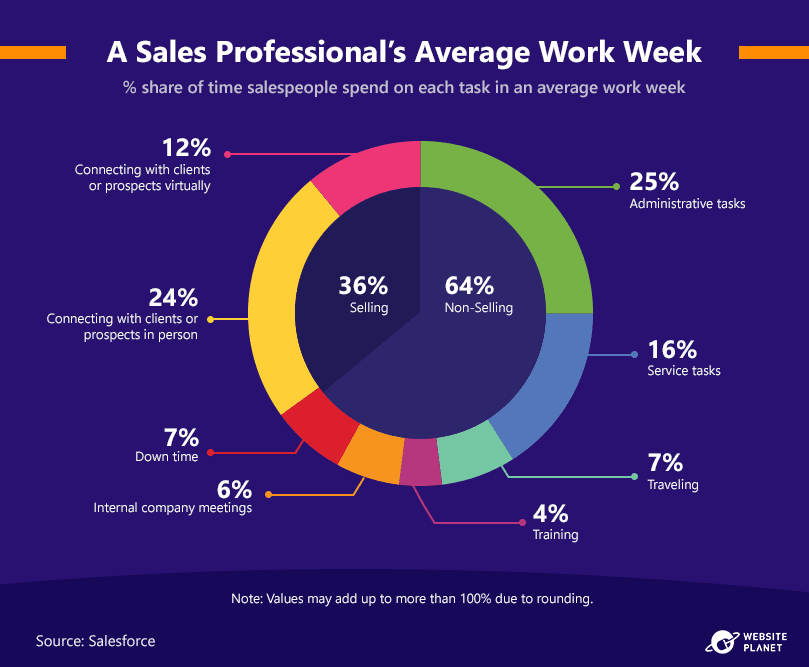 Salespeople have a range of different responsibilities and tasks to complete throughout the week.
The average sales professional only spends 36% of their time selling. 24% of which involves face-to-face client interaction, with another 12% of their time spent speaking with clients virtually.
25% of a sales professional’s time is spent on administrative tasks, such as data entry. Freeing sales representatives up from these tasks can improve sales efficiency.
Other sales tasks include service tasks, traveling, training, and company meetings — so there’s more to the job than first meets the eye!
Salespeople have a range of different responsibilities and tasks to complete throughout the week.
The average sales professional only spends 36% of their time selling. 24% of which involves face-to-face client interaction, with another 12% of their time spent speaking with clients virtually.
25% of a sales professional’s time is spent on administrative tasks, such as data entry. Freeing sales representatives up from these tasks can improve sales efficiency.
Other sales tasks include service tasks, traveling, training, and company meetings — so there’s more to the job than first meets the eye!
21. Introverted vs. Extroverted Sales
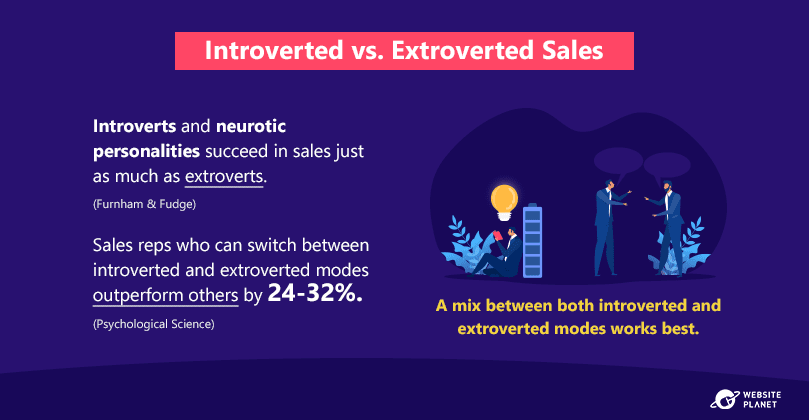 Most people have an image of the prototypical salesperson in their mind — a confident, extroverted yuppie who won’t take no for an answer.
Well? It turns out sales isn’t just about being “extroverted.” In fact, that isn’t favorable in today’s selling landscape, maybe because people have become so accustomed to it.
Instead, sales professionals should opt for a mixture of extroverted and introverted modes. Be softly spoken, calm, and a good listener at certain times during a sale. Take the lead when you want to promote action and get the deal over the line.
Most people have an image of the prototypical salesperson in their mind — a confident, extroverted yuppie who won’t take no for an answer.
Well? It turns out sales isn’t just about being “extroverted.” In fact, that isn’t favorable in today’s selling landscape, maybe because people have become so accustomed to it.
Instead, sales professionals should opt for a mixture of extroverted and introverted modes. Be softly spoken, calm, and a good listener at certain times during a sale. Take the lead when you want to promote action and get the deal over the line.
22. Good Training Impacts Sales Teams
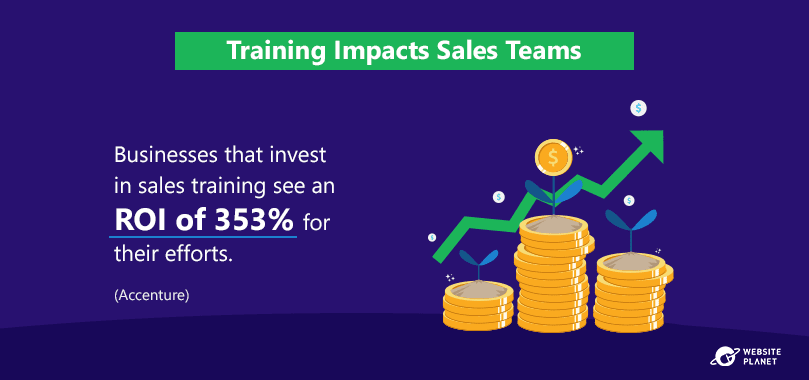 Investing in sales training is worthwhile for sales teams and businesses. Sales training may be costly, but equipping sales teams with the best mental tools can return over 3.5X the initially invested money.
For the record, sales teams do invest heavily in sales training. US sales teams spend more than $70bn a year on sales training, not to mention around $1bn on executive coaching.
That’s because sales training works. 80% of high-performing sales teams believe they have either an “outstanding” or “very good” sales training process (Salesforce).
Optimizing that process is crucial, though sales managers should remain patient with new recruits. New sales reps need around 10 weeks of training on average, and they only get productive results after 11 months on the job.
Investing in sales training is worthwhile for sales teams and businesses. Sales training may be costly, but equipping sales teams with the best mental tools can return over 3.5X the initially invested money.
For the record, sales teams do invest heavily in sales training. US sales teams spend more than $70bn a year on sales training, not to mention around $1bn on executive coaching.
That’s because sales training works. 80% of high-performing sales teams believe they have either an “outstanding” or “very good” sales training process (Salesforce).
Optimizing that process is crucial, though sales managers should remain patient with new recruits. New sales reps need around 10 weeks of training on average, and they only get productive results after 11 months on the job.
23. Using Tech to Train Salespeople
 The best sales teams integrate technology into sales training processes to improve their efficacy.
Businesses can use technology to teach new recruits in several different ways. Use e-learning resources to inform recruits about specific topics, or virtual workshops to help new sales reps apply the skills they’ve learned in a practical situation.
Video conferencing is another technology sales teams can use in the sales training process. Teams use video conferencing to facilitate group collaboration while giving new reps real-time feedback.
Overall, training through technology increases information retention, which is why it’s so efficient!
The best sales teams integrate technology into sales training processes to improve their efficacy.
Businesses can use technology to teach new recruits in several different ways. Use e-learning resources to inform recruits about specific topics, or virtual workshops to help new sales reps apply the skills they’ve learned in a practical situation.
Video conferencing is another technology sales teams can use in the sales training process. Teams use video conferencing to facilitate group collaboration while giving new reps real-time feedback.
Overall, training through technology increases information retention, which is why it’s so efficient!
24. Managing Your Sales Team
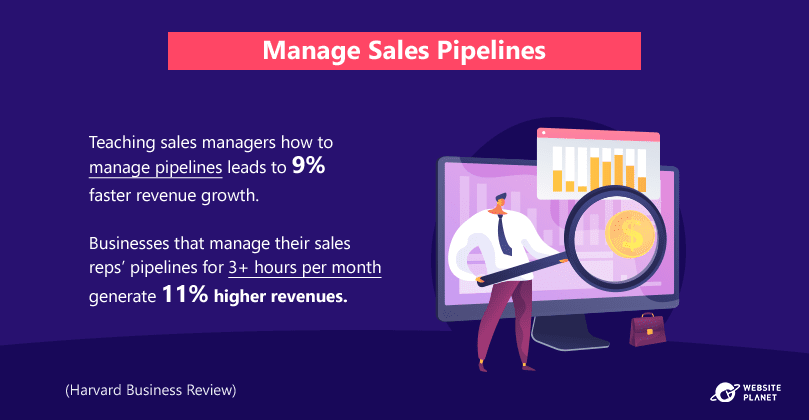 One final training technique before moving on: sales teams should train managers to check in on sales reps’ pipelines. This can directly cause significant revenue growth for businesses.
Companies that train managers to monitor pipelines grow revenue 9% faster than other companies. This may sound a little bit like micromanaging, but it really does work. Making the most of managers’ expertise sees returns.
Pipeline management doesn’t have to be a huge time commitment either. Just 3 hours of pipeline management per month can boost revenue by a whopping 11%.
One final training technique before moving on: sales teams should train managers to check in on sales reps’ pipelines. This can directly cause significant revenue growth for businesses.
Companies that train managers to monitor pipelines grow revenue 9% faster than other companies. This may sound a little bit like micromanaging, but it really does work. Making the most of managers’ expertise sees returns.
Pipeline management doesn’t have to be a huge time commitment either. Just 3 hours of pipeline management per month can boost revenue by a whopping 11%.
25. How Do Teams Use Data Insights?
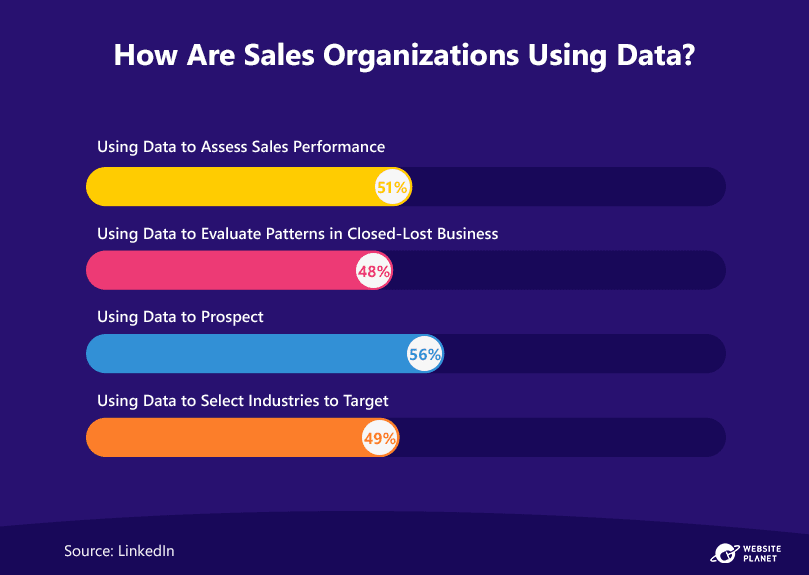 Sales professionals are utilizing data insights as both a way to analyze sales performance and as a way to aid the sales process.
51% of sales professionals are using data to assess sales performance. This could be in the form of forecasts, which chart the expected sales/revenue of the business. 50% of sales teams use data to create forecasts, and these teams are 1.5X more likely to see results (Salesforce).
Sales teams are also leveraging data to analyze lost business, and as a way to target new industries and customers.
Sales professionals are utilizing data insights as both a way to analyze sales performance and as a way to aid the sales process.
51% of sales professionals are using data to assess sales performance. This could be in the form of forecasts, which chart the expected sales/revenue of the business. 50% of sales teams use data to create forecasts, and these teams are 1.5X more likely to see results (Salesforce).
Sales teams are also leveraging data to analyze lost business, and as a way to target new industries and customers.
26. Great Salespeople Check Insights Daily
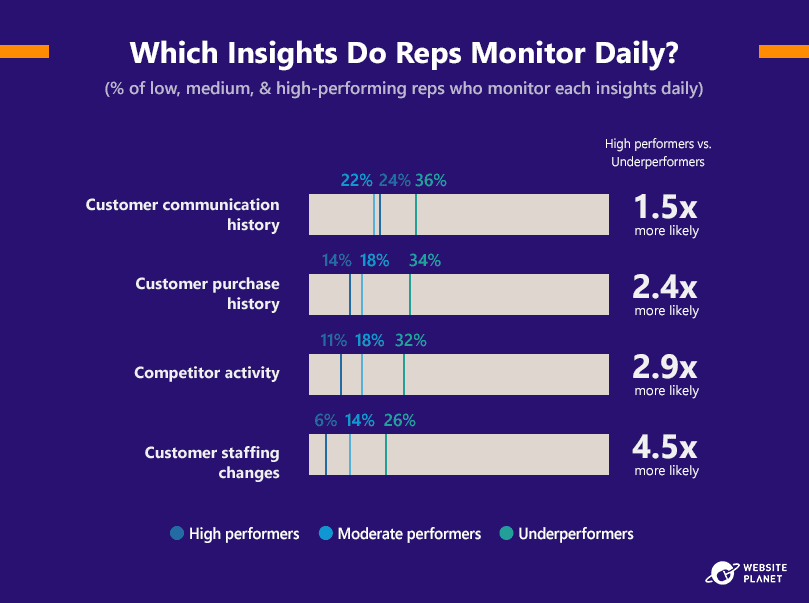 The very best sales professionals are slightly obsessive about their insights. High performers monitor data regularly to stay ahead of the curve on their current business and prospects.
Communication history and purchase history are the 2 metrics that sales professionals check more often than others. Teams also look at competitor activity and staffing changes, with the latter prioritized by top-performers far more often than others.
The very best sales professionals are slightly obsessive about their insights. High performers monitor data regularly to stay ahead of the curve on their current business and prospects.
Communication history and purchase history are the 2 metrics that sales professionals check more often than others. Teams also look at competitor activity and staffing changes, with the latter prioritized by top-performers far more often than others.
27. Data Challenges For Salespeople
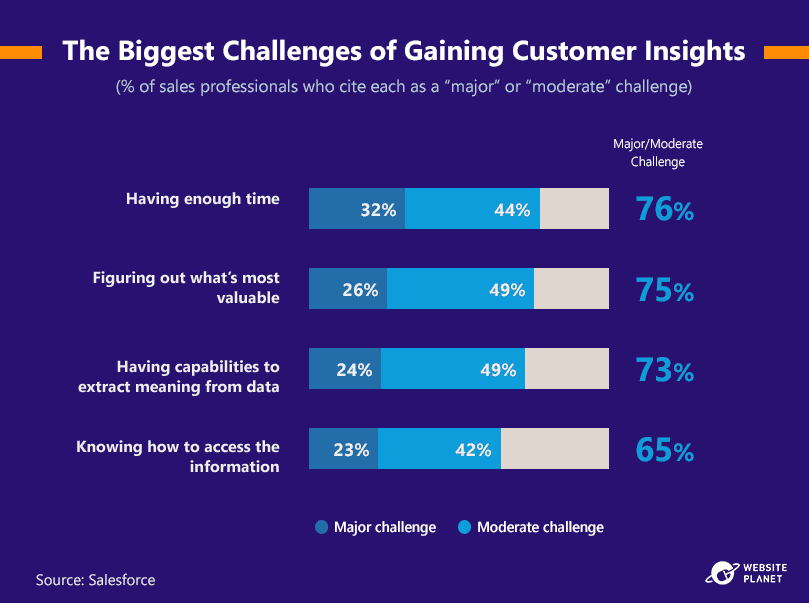 Customer insights are a complex area of sales. What struggles are teams having when interpreting customer data?
“Having enough time” is the biggest challenge of customer insights. Sales teams have so much on their plate that they often fail to find the time for insights, yet the effectiveness of data suggests they should make time.
Sales teams also find it challenging to identify the most valuable prospects and extract the correct meaning from their data insights. Hiring team members with experience in data insights should reduce the effects of these 2 issues.
Customer insights are a complex area of sales. What struggles are teams having when interpreting customer data?
“Having enough time” is the biggest challenge of customer insights. Sales teams have so much on their plate that they often fail to find the time for insights, yet the effectiveness of data suggests they should make time.
Sales teams also find it challenging to identify the most valuable prospects and extract the correct meaning from their data insights. Hiring team members with experience in data insights should reduce the effects of these 2 issues.
28. How Do Sales Reps And Organizations Operate?
 Sales organizations are favoring a mix of autonomy and protocol during the COVID-19 pandemic. While reps are encouraged to operate with flexibility, there are also specific processes that they must follow.
Sales reps check in with managers through one such process: reporting. This assures every update to a prospect or customer account is logged in case it is needed later reference.
Sales organizations are favoring a mix of autonomy and protocol during the COVID-19 pandemic. While reps are encouraged to operate with flexibility, there are also specific processes that they must follow.
Sales reps check in with managers through one such process: reporting. This assures every update to a prospect or customer account is logged in case it is needed later reference.
29. Salespeoples’ Priorities
 Sales teams have a long list of goals and priorities they want to achieve moving forward. Top of this list is improving their communication, with better sales results expected for teams that provide the best customer service.
Sales teams also want to improve their productivity while leveraging existing accounts. Repeat business, approach-stage planning, and inspirational thinking are 3 additional areas sales teams would like to improve.
Sales teams have a long list of goals and priorities they want to achieve moving forward. Top of this list is improving their communication, with better sales results expected for teams that provide the best customer service.
Sales teams also want to improve their productivity while leveraging existing accounts. Repeat business, approach-stage planning, and inspirational thinking are 3 additional areas sales teams would like to improve.
30. How COVID-19 Changed Sales
 Social distancing rules and general anxiety surrounding the pandemic have changed how many sales teams must operate. Face-to-face interaction has reduced significantly, and as such, gaining new business has been difficult for many sales teams.
There’s increased importance in nurturing existing long-term contacts. The selling process has altered, too; buyer trust is now of paramount importance amid social and economic unrest.
As sales professionals readjusted to a new reality, strategy planning, coordination, and performance analysis were the 3 most prominent areas of change in 2020 (Salesforce).
With sales-to-customer interactions altering for the foreseeable future, teams now define success differently.
Social distancing rules and general anxiety surrounding the pandemic have changed how many sales teams must operate. Face-to-face interaction has reduced significantly, and as such, gaining new business has been difficult for many sales teams.
There’s increased importance in nurturing existing long-term contacts. The selling process has altered, too; buyer trust is now of paramount importance amid social and economic unrest.
As sales professionals readjusted to a new reality, strategy planning, coordination, and performance analysis were the 3 most prominent areas of change in 2020 (Salesforce).
With sales-to-customer interactions altering for the foreseeable future, teams now define success differently.
31. Struggling Customers Also Impacted Sales
 Customers were struggling every bit as much as sales teams in 2020. This has directly affected sales performance for a lot of industries.
The economic turmoil of the pandemic led to budget cuts, staff turnover, and general stagnation at client firms. Businesses were not spending freely during the initial stages of the pandemic, reducing productivity for some industry-specific sales professionals.
Customers were struggling every bit as much as sales teams in 2020. This has directly affected sales performance for a lot of industries.
The economic turmoil of the pandemic led to budget cuts, staff turnover, and general stagnation at client firms. Businesses were not spending freely during the initial stages of the pandemic, reducing productivity for some industry-specific sales professionals.
32. Cold vs. Warm Outreach
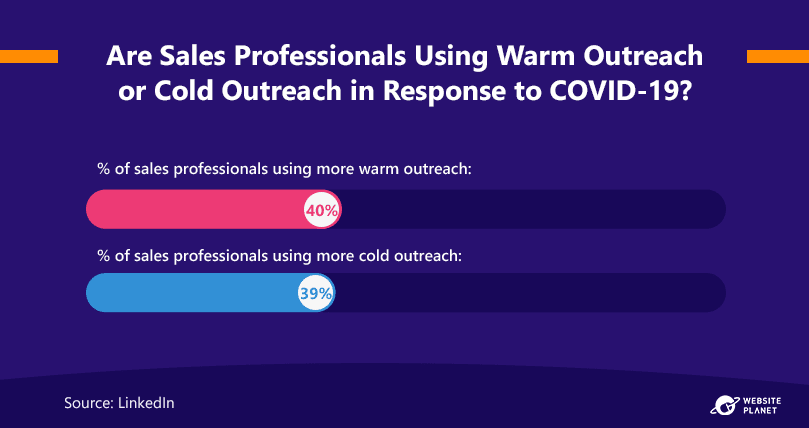 Have sales professionals been reaching out to warm leads or cold leads during the pandemic? Research suggests a bit of both, with warm outreach favored slightly.
Firms prioritized warm prospects during COVID-19. With customers requiring a lot of trust to make a purchase, it makes sense to emphasize the leads that already know a little bit about you and your business.
Have sales professionals been reaching out to warm leads or cold leads during the pandemic? Research suggests a bit of both, with warm outreach favored slightly.
Firms prioritized warm prospects during COVID-19. With customers requiring a lot of trust to make a purchase, it makes sense to emphasize the leads that already know a little bit about you and your business.
33. Changing Roles In Sales
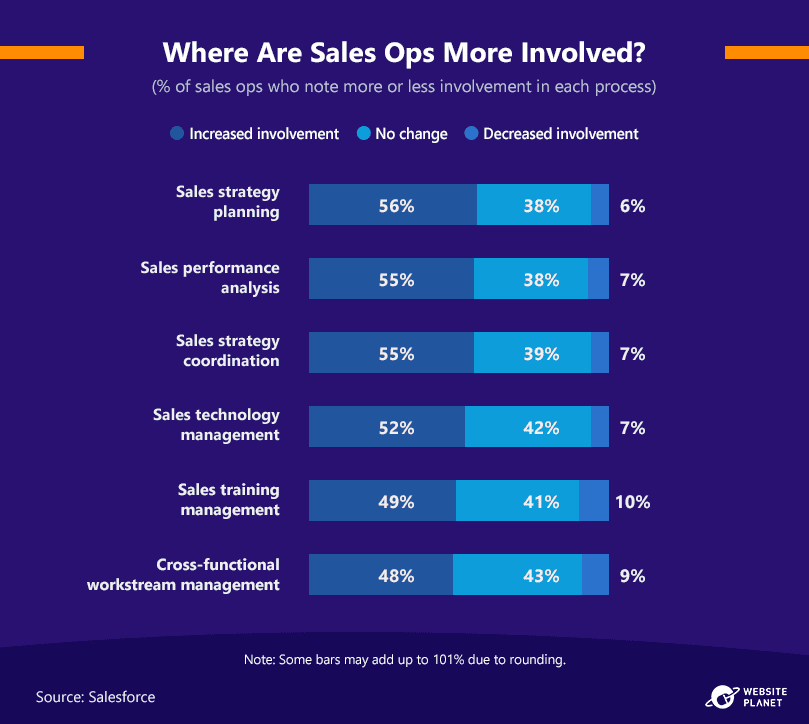 Sales ops are more involved now than ever, with their role taking on added strategic significance during the pandemic.
85% of sales professionals believe this to be the case (Salesforce). Sales ops note they’re more involved in strategic planning, while 55% have a bigger say in performance analysis and coordination.
In fact, a massive 75% of sales ops say they had new responsibilities in 2020.
Sales ops aren’t the only ones to experience significant changes in how they work. 79% of reps have had to adapt to new ways of selling, with 73% of teams increasing the amount they monitor outside sales reps’ activities.
Overall, role changes look as though they are here to stay. 58% of sales reps think their role will change permanently.
Sales ops are more involved now than ever, with their role taking on added strategic significance during the pandemic.
85% of sales professionals believe this to be the case (Salesforce). Sales ops note they’re more involved in strategic planning, while 55% have a bigger say in performance analysis and coordination.
In fact, a massive 75% of sales ops say they had new responsibilities in 2020.
Sales ops aren’t the only ones to experience significant changes in how they work. 79% of reps have had to adapt to new ways of selling, with 73% of teams increasing the amount they monitor outside sales reps’ activities.
Overall, role changes look as though they are here to stay. 58% of sales reps think their role will change permanently.
34. Top Sales Challenges In 2020
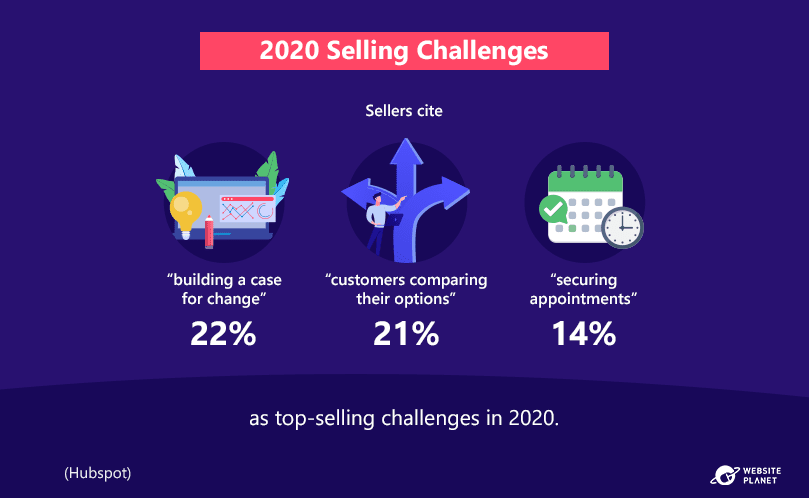 Sales teams struggled to adapt to new ways of business in 2020. COVID-19 created the need to evaluate traditional ways of doing business. However, building a case for these changes was not always easy.
Securing appointments was another difficulty during the throes of 2020. Limits on social contact and general consumer anxieties were, without doubt, a contributing factor here.
Sales teams struggled to adapt to new ways of business in 2020. COVID-19 created the need to evaluate traditional ways of doing business. However, building a case for these changes was not always easy.
Securing appointments was another difficulty during the throes of 2020. Limits on social contact and general consumer anxieties were, without doubt, a contributing factor here.
35. Tactics for Future Success
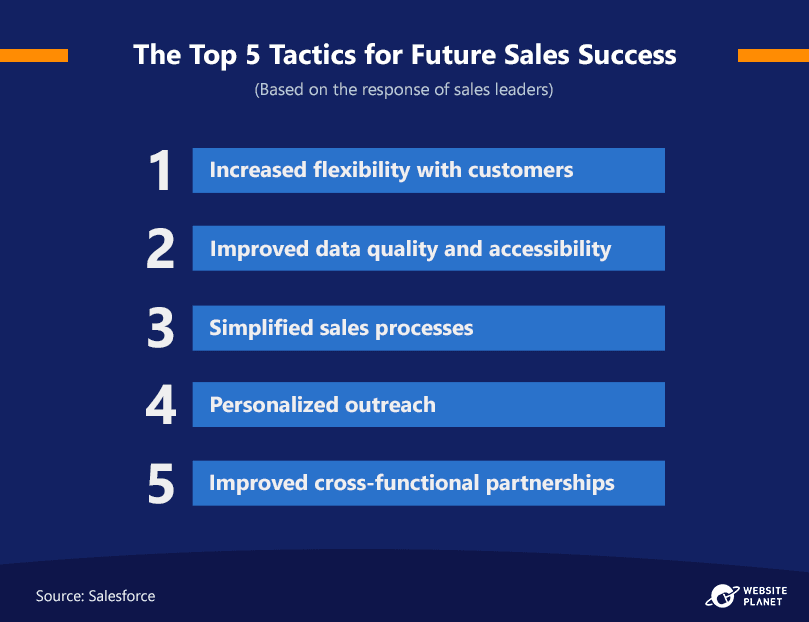 Sales leaders think flexibility and data quality are the keys to future sales success. Streamlining the customer’s experience, either through simple sales processes or personalized elements, also looks as though it will be necessary for salespeople moving forward.
Sales leaders think flexibility and data quality are the keys to future sales success. Streamlining the customer’s experience, either through simple sales processes or personalized elements, also looks as though it will be necessary for salespeople moving forward.
36. Adapting for the Future
 Leading sales professionals are more confident about their ability to adapt to changes across a range of areas.
Top-performers are 6.7X more likely to be unfazed by technology changes and 6.3X as likely to tackle strategy alterations confidently.
This explains why top-performers can deal with the adversity of the COVID-19 pandemic, though all sales professionals are confident about future growth.
97% of sales VPs and 95% of sales managers/directors are confident to some degree that their companies will experience future growth as industries seek to recover from the COVID-19 pandemic.
Leading sales professionals are more confident about their ability to adapt to changes across a range of areas.
Top-performers are 6.7X more likely to be unfazed by technology changes and 6.3X as likely to tackle strategy alterations confidently.
This explains why top-performers can deal with the adversity of the COVID-19 pandemic, though all sales professionals are confident about future growth.
97% of sales VPs and 95% of sales managers/directors are confident to some degree that their companies will experience future growth as industries seek to recover from the COVID-19 pandemic.
Customer Experience in Sales
Customer experience is the (not so) secret sauce of sales. Sales teams can expect huge returns if they perfect the customers’ business experience, whether in B2B or B2C sales.37. The Customer Always Comes First
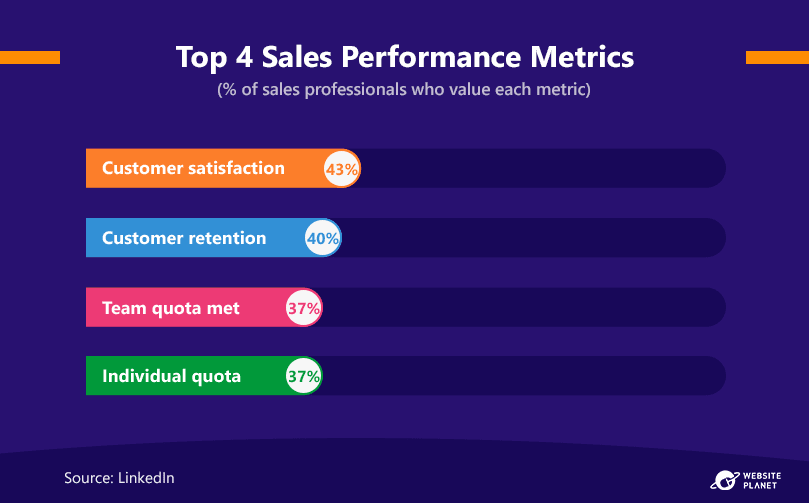 The customer always comes first. Customer satisfaction is the most important metric for sales teams because it’s the most critical factor in sales success.
43% of teams value this over any other metric. If customers are satisfied with their experience, word-of-mouth can grow your brand. Happy customers are more likely to return to your business in the future too. Customer retention is the critical indicator of repeat business and is another way to measure a business’ value.
Quotas and targets are measured by sales teams as well, though providing a great CX is ultimately more important as it can see greater returns down the line.
The customer always comes first. Customer satisfaction is the most important metric for sales teams because it’s the most critical factor in sales success.
43% of teams value this over any other metric. If customers are satisfied with their experience, word-of-mouth can grow your brand. Happy customers are more likely to return to your business in the future too. Customer retention is the critical indicator of repeat business and is another way to measure a business’ value.
Quotas and targets are measured by sales teams as well, though providing a great CX is ultimately more important as it can see greater returns down the line.
38. Going the Extra Mile
 Business buyers want a personal experience from sales professionals.
Businesses want sales reps focused on solving their problems, first and foremost. Pushy reps focused on a quick sale do not cut it in the B2B sales world. Buyers want maximum value.
Availability is another favored trait amongst B2B buyers, while 79% want a sales professional who understands their companies’ preferences and needs. Salespeople recognize this too. 90% of sales reps think it’s important to anticipate their customers’ needs (Salesforce).
79% of buyers want a sales pro that acts like a personal trusted advisor rather than just another sales rep. This explains why 75% of reps say they connect to their customers personally.
Business buyers want a personal experience from sales professionals.
Businesses want sales reps focused on solving their problems, first and foremost. Pushy reps focused on a quick sale do not cut it in the B2B sales world. Buyers want maximum value.
Availability is another favored trait amongst B2B buyers, while 79% want a sales professional who understands their companies’ preferences and needs. Salespeople recognize this too. 90% of sales reps think it’s important to anticipate their customers’ needs (Salesforce).
79% of buyers want a sales pro that acts like a personal trusted advisor rather than just another sales rep. This explains why 75% of reps say they connect to their customers personally.
39. Trust Defines Sales Success
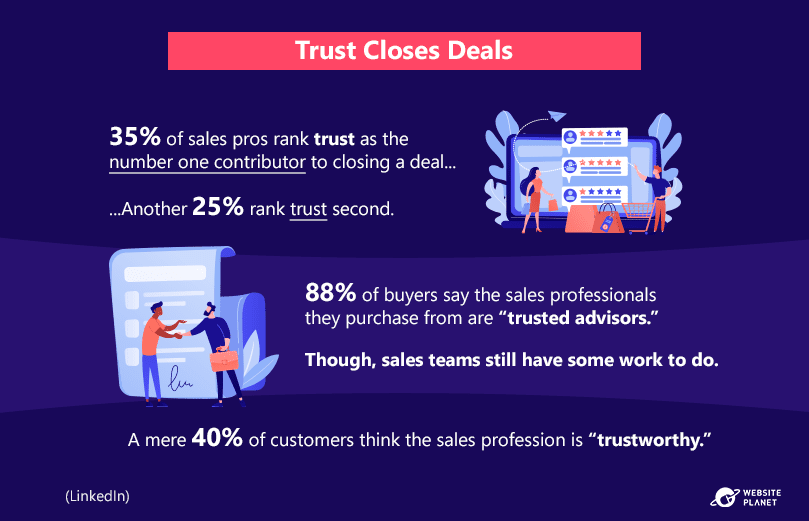 Trust is the defining factor in sales success. Without trust, buyers and consumers will never make the purchase, and sellers will never close the deal.
Salesforce’s study referenced the importance of becoming a “trusted advisor.” LinkedIn found the same connection between trust and sales. Buyers say nearly 88% of the salespeople they eventually buy from are “trusted advisors.”
Buyers and sellers alike prioritize trust as the most crucial part of closing a deal. However, only 40% of people think the sales profession is “trustworthy.”
In which case, salespeople have some work to do. Focusing on building trust will see higher returns on close rates.
Trust is the defining factor in sales success. Without trust, buyers and consumers will never make the purchase, and sellers will never close the deal.
Salesforce’s study referenced the importance of becoming a “trusted advisor.” LinkedIn found the same connection between trust and sales. Buyers say nearly 88% of the salespeople they eventually buy from are “trusted advisors.”
Buyers and sellers alike prioritize trust as the most crucial part of closing a deal. However, only 40% of people think the sales profession is “trustworthy.”
In which case, salespeople have some work to do. Focusing on building trust will see higher returns on close rates.
40. Trust Retains Customers
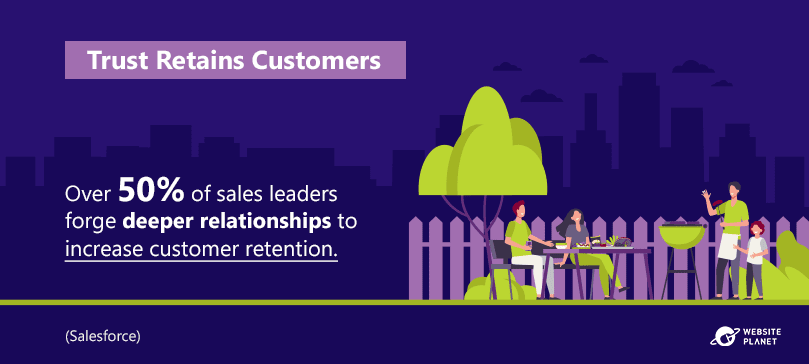 Trust is the most critical factor in a customer’s experience of your business. They need to trust your brand to make a sale, but trust is also crucial for customer retention.
More than half of sales leaders are retaining customers by building deeper customer relationships. Improving customer retention should be in the best interests of any sales professional; 70% of sales leaders agree that existing customers drive revenue growth (Gartner).
The difference customer retention makes to company growth is staggering. Increasing customer retention by just 5% leads to a 25-90% lift in profits. A primary reason behind such development is the ROI of retaining customers. Adding a new customer costs 5-25X more than keeping one you’ve already got.
Trust is the most critical factor in a customer’s experience of your business. They need to trust your brand to make a sale, but trust is also crucial for customer retention.
More than half of sales leaders are retaining customers by building deeper customer relationships. Improving customer retention should be in the best interests of any sales professional; 70% of sales leaders agree that existing customers drive revenue growth (Gartner).
The difference customer retention makes to company growth is staggering. Increasing customer retention by just 5% leads to a 25-90% lift in profits. A primary reason behind such development is the ROI of retaining customers. Adding a new customer costs 5-25X more than keeping one you’ve already got.
41. How To Build Trust (& a Better Customer Experience)?
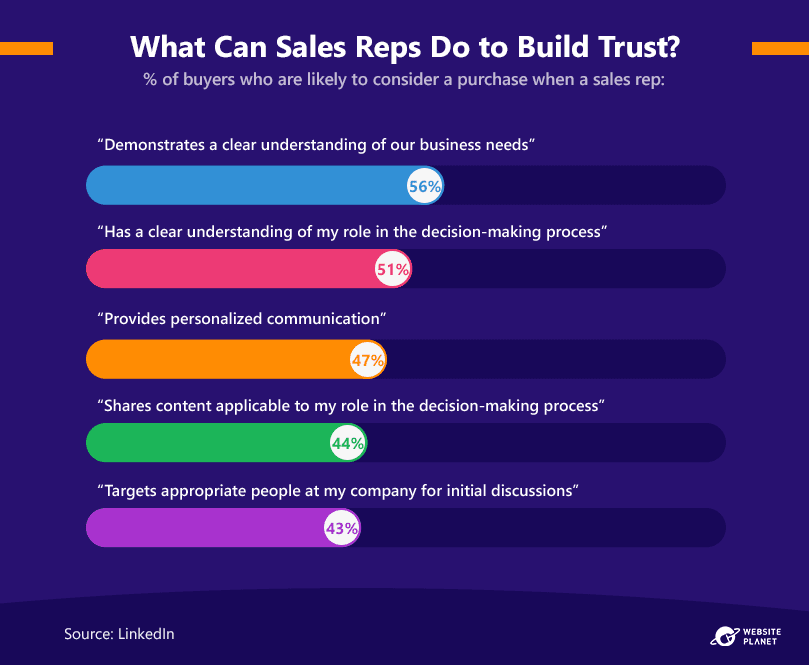 Sales reps can build trust by demonstrating a detailed understanding of buyers and their business.
Buyers don’t want to waste time. Sales reps that can hit the ground running have a higher chance of making the sale. B2B buyers also want relevant communications at every stage of the buying process. No generic messaging or needless conversations.
A separate study found concurrent results. “Listen to my needs” was rated by 69% of buyers as the best way a sales rep can improve customer experience (CX) (Hubspot). “Provides relevant information” was rated third-most important (61%), while “is not pushy” was also ranked as an essential way to build a satisfactory experience (61%).
Sales reps can build trust by demonstrating a detailed understanding of buyers and their business.
Buyers don’t want to waste time. Sales reps that can hit the ground running have a higher chance of making the sale. B2B buyers also want relevant communications at every stage of the buying process. No generic messaging or needless conversations.
A separate study found concurrent results. “Listen to my needs” was rated by 69% of buyers as the best way a sales rep can improve customer experience (CX) (Hubspot). “Provides relevant information” was rated third-most important (61%), while “is not pushy” was also ranked as an essential way to build a satisfactory experience (61%).
*42. What Other CX Elements Are Important in B2C?
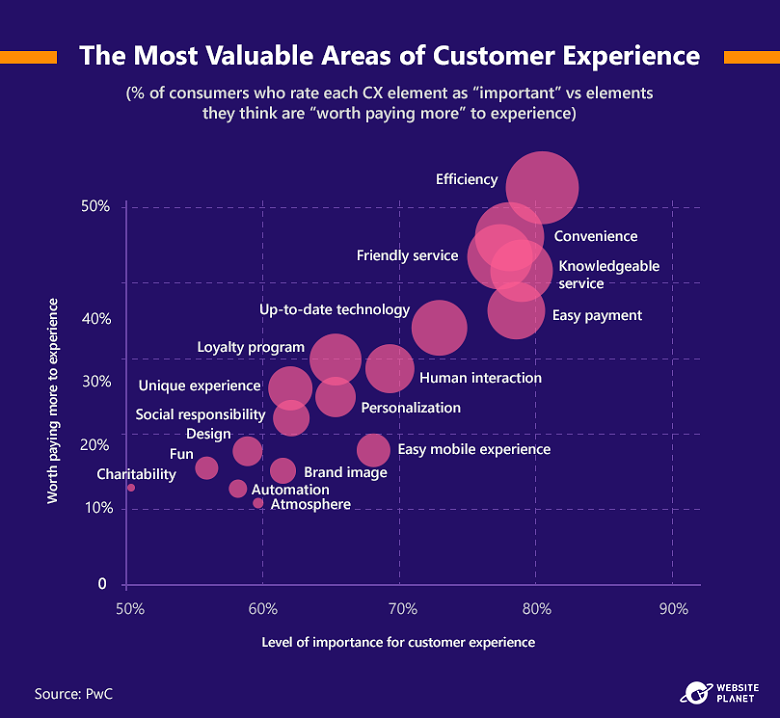 A few additional elements make up a fantastic experience for B2C customers.
Factors like “efficiency” and “knowledgeable service” are still super-relevant in the B2C sector and resonate with the needs of B2B buyers.
Consumers want streamlined processes, like quick payment options, mobile optimization, and cutting-edge technologies. These processes make the purchase more “convenient.”
Shoppers typically decide on a purchase faster than B2B customers, so it makes sense that shoppers place a greater emphasis on speed.
A few additional elements make up a fantastic experience for B2C customers.
Factors like “efficiency” and “knowledgeable service” are still super-relevant in the B2C sector and resonate with the needs of B2B buyers.
Consumers want streamlined processes, like quick payment options, mobile optimization, and cutting-edge technologies. These processes make the purchase more “convenient.”
Shoppers typically decide on a purchase faster than B2B customers, so it makes sense that shoppers place a greater emphasis on speed.
43. When Do Buyers Want Help?
 At what point in the buyer’s journey should sales professionals prioritize their communications with potential leads?
One study shows that customers want to speak with a salesperson in the consideration phase. Here, the customer has compiled initial research and would likely have a list of questions they want to ask a sales professional.
At what point in the buyer’s journey should sales professionals prioritize their communications with potential leads?
One study shows that customers want to speak with a salesperson in the consideration phase. Here, the customer has compiled initial research and would likely have a list of questions they want to ask a sales professional.
44. Personalization Improves CX
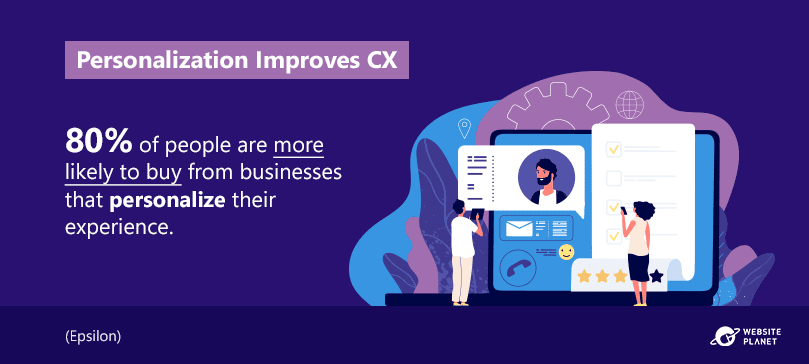 Personalization is crucial for building customer trust and sales success. Personalization helps sales professionals ensure communications are always hyper-relevant to the customer or client.
Top sales teams are 2.8X more likely to have become more focused on personalizing customer experiences (Salesforce). Despite the impact personalization can have on sales performance, sales departments still chronically underused it.
A meager 13% of businesses use personalization in their sales departments (SuperOffice). That marks sales as the most underappreciated personalization area, yet sales departments could benefit the most.
Personalization is crucial for building customer trust and sales success. Personalization helps sales professionals ensure communications are always hyper-relevant to the customer or client.
Top sales teams are 2.8X more likely to have become more focused on personalizing customer experiences (Salesforce). Despite the impact personalization can have on sales performance, sales departments still chronically underused it.
A meager 13% of businesses use personalization in their sales departments (SuperOffice). That marks sales as the most underappreciated personalization area, yet sales departments could benefit the most.
45. Live Chat Is Important for Sales Reps
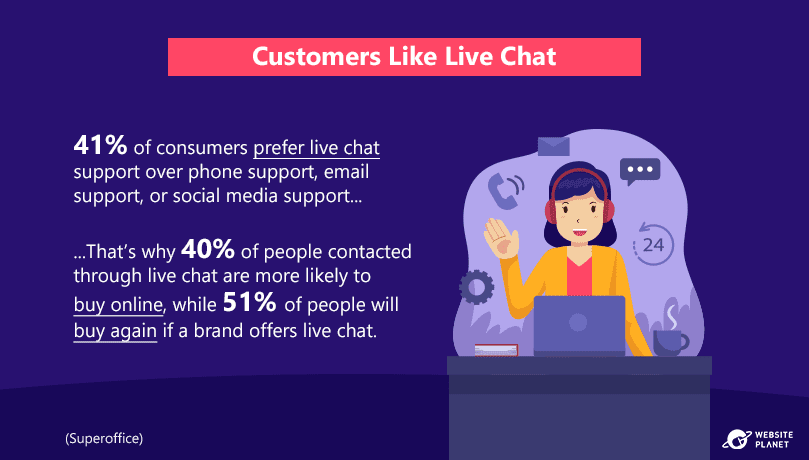 Live chat should be one of the most crucial types of personalization for eCommerce sales professionals. Customers prefer live chat over other methods of communication. This increased level of engagement leads to an increase in sales and customer retention.
Live chat places the consumer in direct contact with a sales professional based on their specific needs.
Live chat can create opportunities for upselling, while customers value these elements of personal contact. 84% of shoppers say being treated like a person rather than a number is a “very important” part of winning their business (Salesforce).
Live chat should be one of the most crucial types of personalization for eCommerce sales professionals. Customers prefer live chat over other methods of communication. This increased level of engagement leads to an increase in sales and customer retention.
Live chat places the consumer in direct contact with a sales professional based on their specific needs.
Live chat can create opportunities for upselling, while customers value these elements of personal contact. 84% of shoppers say being treated like a person rather than a number is a “very important” part of winning their business (Salesforce).
46. Which Industries Are Getting CX Right?
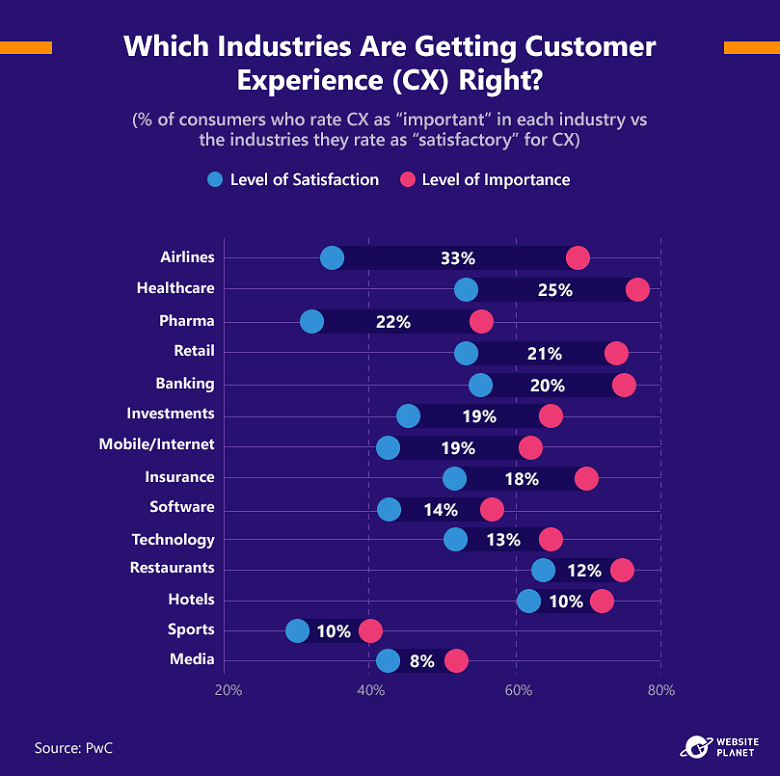 Which industries are smashing customer experience out of the park? Not many of them, judging by the above graphic.
Some industries where the customer experience is “important” are failing to deliver. Notably, customer experience is significant for airlines, yet consumers rate the industry as one of the biggest underperformers.
Customer service is vital in the hospitality sector too. For the most part, restaurants and hotels deliver a good level of customer service to consumers.
Which industries are smashing customer experience out of the park? Not many of them, judging by the above graphic.
Some industries where the customer experience is “important” are failing to deliver. Notably, customer experience is significant for airlines, yet consumers rate the industry as one of the biggest underperformers.
Customer service is vital in the hospitality sector too. For the most part, restaurants and hotels deliver a good level of customer service to consumers.
The Sales Process
Ahhhh, the all-important sales process. This is where sales professionals earn their money. So, from start to finish, what techniques should you use to make prospecting, pitching, and closing a seamless operation? Of course, continue to focus on building a great CX. We’re talking about cold-hard cash here.47. What Is the Sales Process?
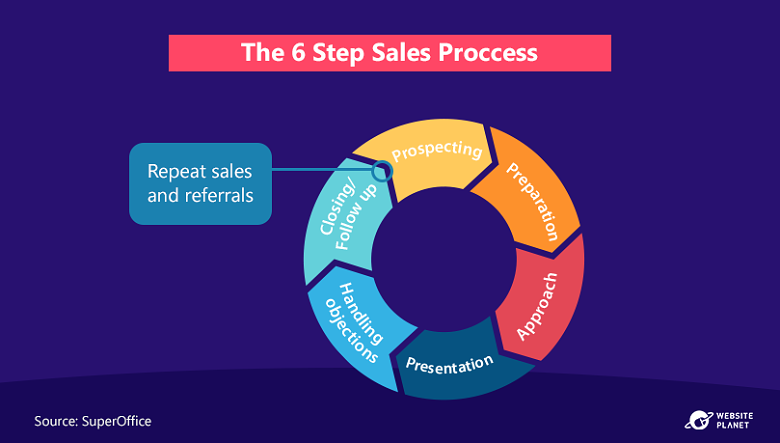 We need to know what “the sales process” is before speaking about it in-depth. Here it is in circle-form — the circle of life for your average sales rep.
The sales process outlines the steps salespeople must take at each stage of the buyer’s journey when making a sale. The 6 steps outlined above show the entire process, from identifying potential leads (prospecting) to planning a strategy, approaching the prospect, presenting, and closing/following-up.
FYI, a follow-up describes a situation where a salesperson gets in touch with the lead after initial contact to promote action.
We need to know what “the sales process” is before speaking about it in-depth. Here it is in circle-form — the circle of life for your average sales rep.
The sales process outlines the steps salespeople must take at each stage of the buyer’s journey when making a sale. The 6 steps outlined above show the entire process, from identifying potential leads (prospecting) to planning a strategy, approaching the prospect, presenting, and closing/following-up.
FYI, a follow-up describes a situation where a salesperson gets in touch with the lead after initial contact to promote action.
48. Prospecting Is a Challenge
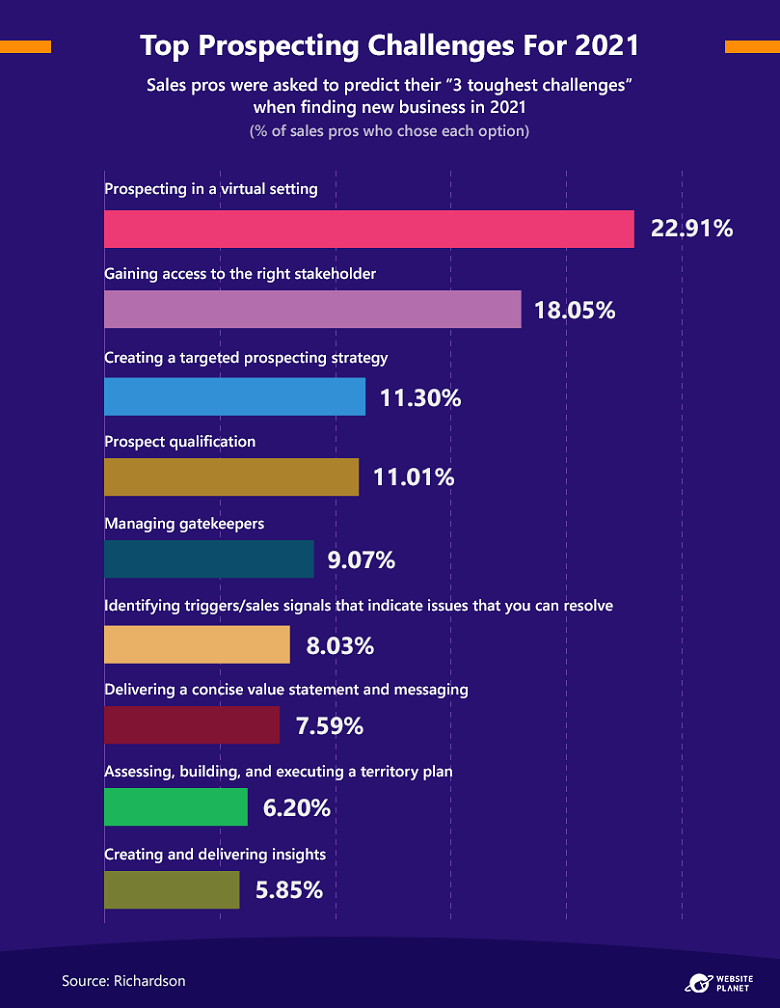 Prospecting is tough. 42% of sales professionals rate prospecting as the most challenging thing about sales, ahead of closing and qualifying (Hubspot).
Virtual prospecting is a top challenge for sales pros. Contacting the right people, and having the correct prospecting strategy, are 2 more key difficulties for prospectors.
Sales professionals often don’t have the means available to maximize the value of their prospecting efforts. 42% of sales reps don’t have enough information when they make the first call (SPOTIO), a key reason so many prospectors are struggling with strategy, access, and targeting.
The difficulties of prospecting mean most sales professionals don’t enjoy it. Two-thirds of sellers say they struggle with a lack of motivation to prospect (RainGroup).
Prospecting is tough. 42% of sales professionals rate prospecting as the most challenging thing about sales, ahead of closing and qualifying (Hubspot).
Virtual prospecting is a top challenge for sales pros. Contacting the right people, and having the correct prospecting strategy, are 2 more key difficulties for prospectors.
Sales professionals often don’t have the means available to maximize the value of their prospecting efforts. 42% of sales reps don’t have enough information when they make the first call (SPOTIO), a key reason so many prospectors are struggling with strategy, access, and targeting.
The difficulties of prospecting mean most sales professionals don’t enjoy it. Two-thirds of sellers say they struggle with a lack of motivation to prospect (RainGroup).
49. How Many Prospects Do You need?
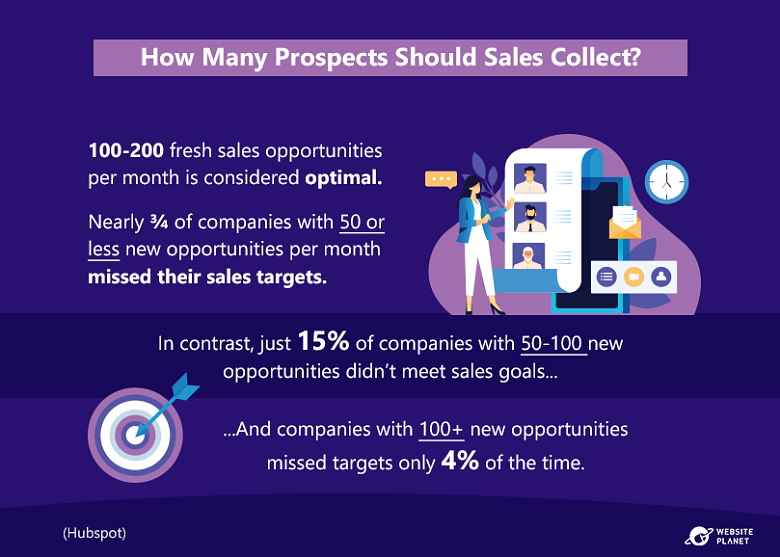 Hubspot data shows that between 100-200 leads per month is about the perfect amount for your average sales team. Dip below 50 sales opportunities per month, and sales teams risk damaging their ability to meet sales goals.
Sales pros can’t expect to turn every prospect into a lead. In fact, sales professionals secure a meeting with a prospect about once every 8 interactions (RainGroup), so finding enough of them is crucial.
That being said, the quality of your prospects is considered a higher priority than collecting loads of them. 77% of sales pros say generating “high-quality leads” is their top prospecting priority, as opposed to increasing the number of leads (41%) (Medium).
Hubspot data shows that between 100-200 leads per month is about the perfect amount for your average sales team. Dip below 50 sales opportunities per month, and sales teams risk damaging their ability to meet sales goals.
Sales pros can’t expect to turn every prospect into a lead. In fact, sales professionals secure a meeting with a prospect about once every 8 interactions (RainGroup), so finding enough of them is crucial.
That being said, the quality of your prospects is considered a higher priority than collecting loads of them. 77% of sales pros say generating “high-quality leads” is their top prospecting priority, as opposed to increasing the number of leads (41%) (Medium).
50. How to Prioritize Leads
 Data is the key to prioritizing leads. Sales professionals are more than twice as likely to choose leads based on “propensity to buy” data rather than “intuition,” which, extraordinarily, is the second most popular way to select leads.
Most sales pros are not using data insights to inform this process, instead prioritizing leads “alphabetically” or based on “last in/first out.”
This explains why so many sales professionals are getting prospecting wrong. The average sales team wastes half of its time on unproductive prospecting (Hubspot). That’s because over 40% of prospectors are not targeting the right people (RainGroup).
Uninformed decision-making is not helping the process. Therefore, using data insights to inform lead prioritization is crucial and ensure sales teams target the best prospects.
Data is the key to prioritizing leads. Sales professionals are more than twice as likely to choose leads based on “propensity to buy” data rather than “intuition,” which, extraordinarily, is the second most popular way to select leads.
Most sales pros are not using data insights to inform this process, instead prioritizing leads “alphabetically” or based on “last in/first out.”
This explains why so many sales professionals are getting prospecting wrong. The average sales team wastes half of its time on unproductive prospecting (Hubspot). That’s because over 40% of prospectors are not targeting the right people (RainGroup).
Uninformed decision-making is not helping the process. Therefore, using data insights to inform lead prioritization is crucial and ensure sales teams target the best prospects.
51. What Do Prospects Want to Know?
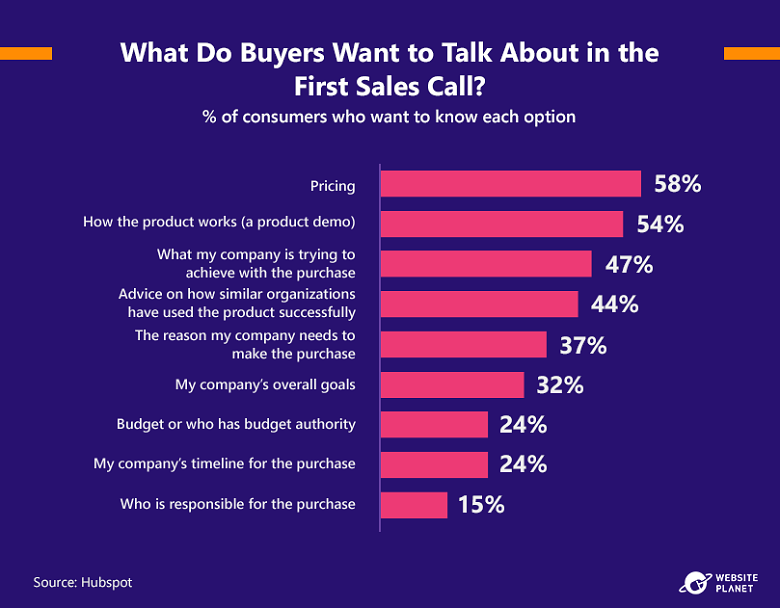 58% of prospects want information about pricing on the first sales call. That means sales professionals need to know their business’ product list inside-out.
54% of buyers want to know how the product works, while details about purchase authority and budget authority are not entirely relevant to buyers on the first sales call.
Hubspot’s data shows a clash of interests between prospectors and buyers. Only a small number of sellers (23%) wish to discuss pricing & product demos on the first call, yet this interests clients the most.
63% of sales reps try to reaffirm the value of their products by highlighting the reasons the buyer’s company needs the product. However, just 37% of buyers want to talk about this.
65% of sales reps want to discuss the goals buyers wish to achieve with the product, but only 47% of buyers want to talk about this on the first call.
58% of prospects want information about pricing on the first sales call. That means sales professionals need to know their business’ product list inside-out.
54% of buyers want to know how the product works, while details about purchase authority and budget authority are not entirely relevant to buyers on the first sales call.
Hubspot’s data shows a clash of interests between prospectors and buyers. Only a small number of sellers (23%) wish to discuss pricing & product demos on the first call, yet this interests clients the most.
63% of sales reps try to reaffirm the value of their products by highlighting the reasons the buyer’s company needs the product. However, just 37% of buyers want to talk about this.
65% of sales reps want to discuss the goals buyers wish to achieve with the product, but only 47% of buyers want to talk about this on the first call.
52. Send Videos to Prospects
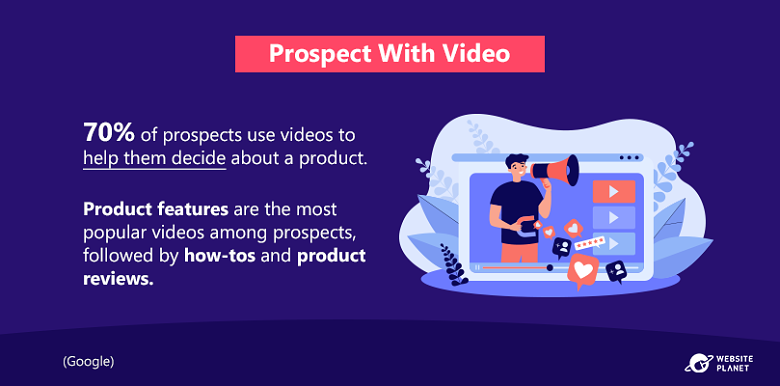 The best sales professionals use videos to their full capacity as part of the sales process. Videos are a highly engaging form of media. What’s more, customers love watching videos to learn more about products.
Sales professionals should be well-stocked with product features, how-tos, and product reviews. Any resource that informs the reader about the way the product works.
Visual forms of media are far more likely to get the message across about your products. Using videos strategically can lift sales, and you won’t even have to say a word!
The best sales professionals use videos to their full capacity as part of the sales process. Videos are a highly engaging form of media. What’s more, customers love watching videos to learn more about products.
Sales professionals should be well-stocked with product features, how-tos, and product reviews. Any resource that informs the reader about the way the product works.
Visual forms of media are far more likely to get the message across about your products. Using videos strategically can lift sales, and you won’t even have to say a word!
53. Top Sales Skills
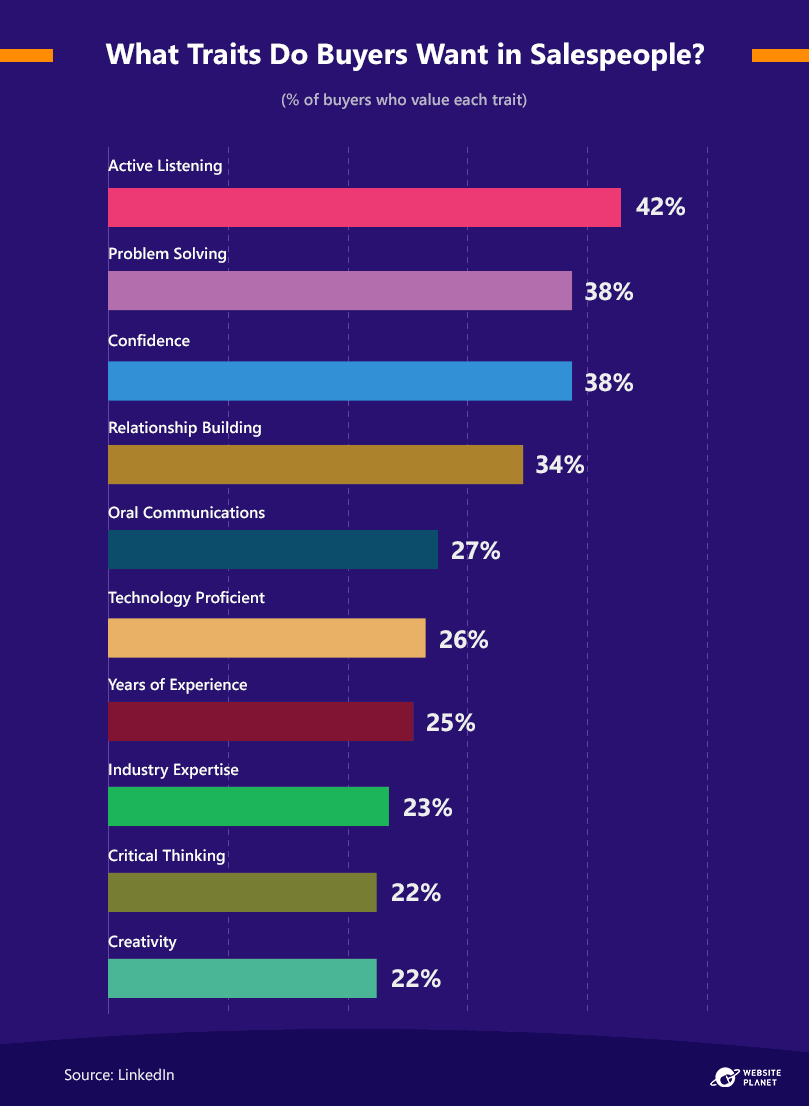 “Active listening” is the top trait buyers want to see in salespeople. As mentioned, buyers want sales professionals to understand their needs, so this isn’t particularly surprising.
Problem-solving skills are also essential for a sales professional, while confidence is crucial. How are customers meant to be confident in a sales pitch if the salesperson isn’t?
Interestingly, sales managers are not hiring for these skills in their workforce. While “active listening” is a key trait for buyers, just 26% of sales managers are looking for this skill.
Buyers also want to see “experience” and “expertise,” yet these traits don’t even figure in the thinking of managers. The data suggests companies could do with realigning their hiring goals to fit the needs of their audience.
“Active listening” is the top trait buyers want to see in salespeople. As mentioned, buyers want sales professionals to understand their needs, so this isn’t particularly surprising.
Problem-solving skills are also essential for a sales professional, while confidence is crucial. How are customers meant to be confident in a sales pitch if the salesperson isn’t?
Interestingly, sales managers are not hiring for these skills in their workforce. While “active listening” is a key trait for buyers, just 26% of sales managers are looking for this skill.
Buyers also want to see “experience” and “expertise,” yet these traits don’t even figure in the thinking of managers. The data suggests companies could do with realigning their hiring goals to fit the needs of their audience.
54. What Do Buyers Want From Negotiations?
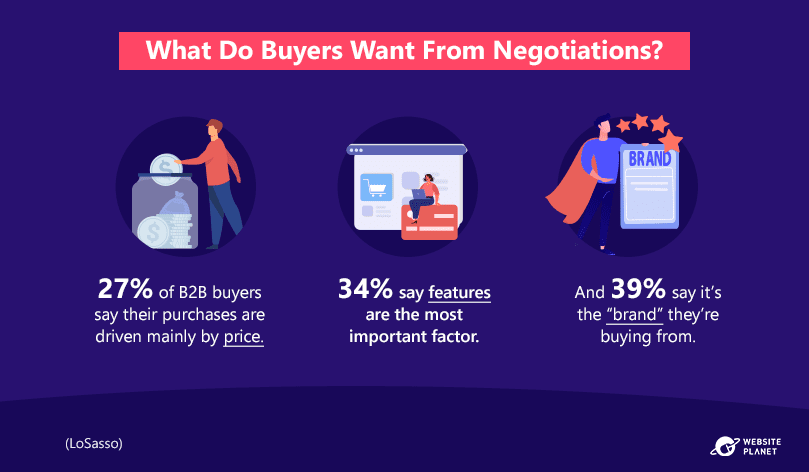 Buyers are looking for sales professionals to deliver on 3 specific areas of value. These points are useful to keep in mind when entering negotiations.
Chiefly among these are “features.” The product comes first for people making a purchase. Sales professionals need to highlight the most important aspects of their product.
Buyers are also looking for a reasonable price — undercutting competitors where possible will lead to higher close rates.
The brand’s reputation is another crucial factor when making purchasing decisions. 70% of buyers choose businesses based on their reputation (LoSasso), which is why building trust is so important.
Buyers are looking for sales professionals to deliver on 3 specific areas of value. These points are useful to keep in mind when entering negotiations.
Chiefly among these are “features.” The product comes first for people making a purchase. Sales professionals need to highlight the most important aspects of their product.
Buyers are also looking for a reasonable price — undercutting competitors where possible will lead to higher close rates.
The brand’s reputation is another crucial factor when making purchasing decisions. 70% of buyers choose businesses based on their reputation (LoSasso), which is why building trust is so important.
55. Ask the Right Questions
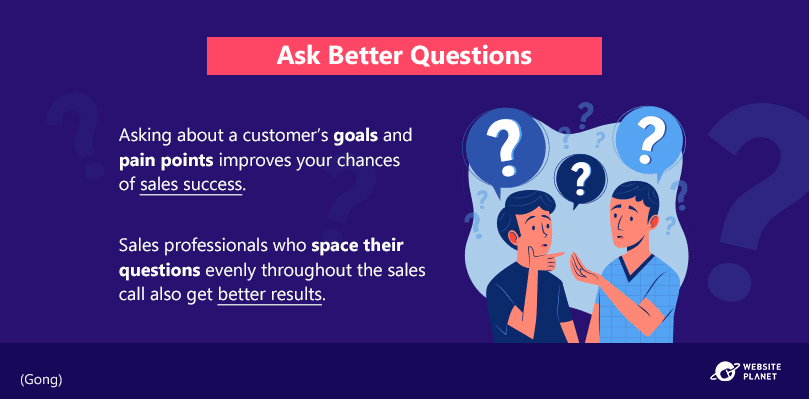 When it comes to liaising with prospects and leads, how should you go about the conversation?
Asking relevant questions about the buyer’s goals/pain points at some stage in the buying process should lead to better sales results. While buyers may not always want to talk about this stuff in the first call, finding out these answers is crucial if sales pros wish to understand the customer’s needs.
Space these all-important questions throughout the conversation to not overwhelm the buyer or appear too pushy.
When it comes to liaising with prospects and leads, how should you go about the conversation?
Asking relevant questions about the buyer’s goals/pain points at some stage in the buying process should lead to better sales results. While buyers may not always want to talk about this stuff in the first call, finding out these answers is crucial if sales pros wish to understand the customer’s needs.
Space these all-important questions throughout the conversation to not overwhelm the buyer or appear too pushy.
56. Be Polite (Not Apologetic)
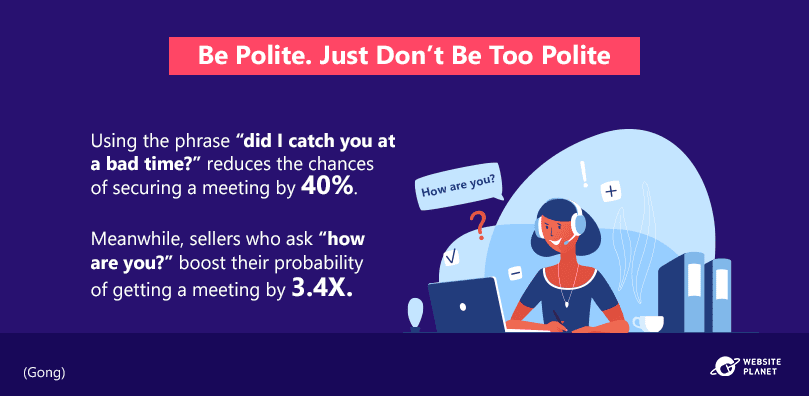 Whether prospecting or cold calling, it works to be polite, while apologetic phrases give prospects a reason to hang up.
Specifically, the phrase “did I catch you at a bad time?” offers prospects an easy route out of the conversation. Don’t use that. Instead, ask the prospect how they’re doing. That should more than triple your likelihood of securing a meeting.
Whether prospecting or cold calling, it works to be polite, while apologetic phrases give prospects a reason to hang up.
Specifically, the phrase “did I catch you at a bad time?” offers prospects an easy route out of the conversation. Don’t use that. Instead, ask the prospect how they’re doing. That should more than triple your likelihood of securing a meeting.
57. Avoid These Words And Phrases
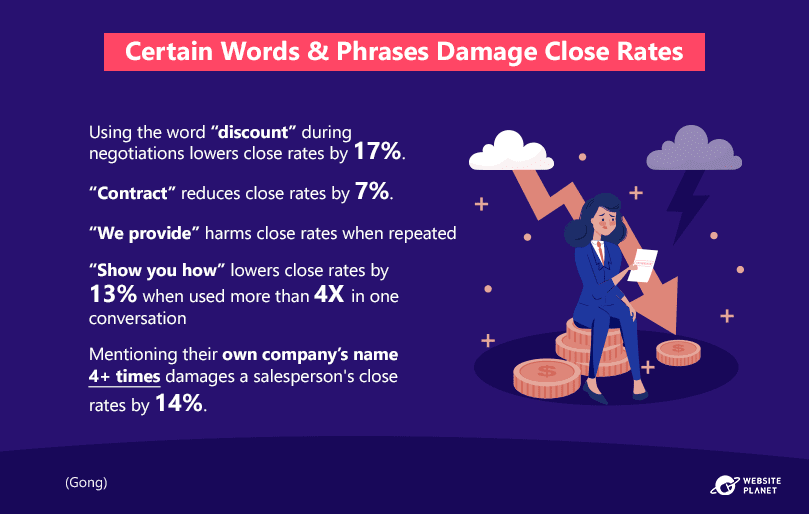 Sales professionals should avoid more than a few phrases when speaking with prospects. Stereotypical “salesy” language does not quite get the job done. According to Gong, phrases like “discount” and “show you how” lower the closing rate by large amounts.
Sales professionals should also be wary of repeating themselves multiple times. If you repeat “we provide” or even your company name, your chances of success quickly diminish.
Sales professionals should avoid more than a few phrases when speaking with prospects. Stereotypical “salesy” language does not quite get the job done. According to Gong, phrases like “discount” and “show you how” lower the closing rate by large amounts.
Sales professionals should also be wary of repeating themselves multiple times. If you repeat “we provide” or even your company name, your chances of success quickly diminish.
58. Use These Words Instead
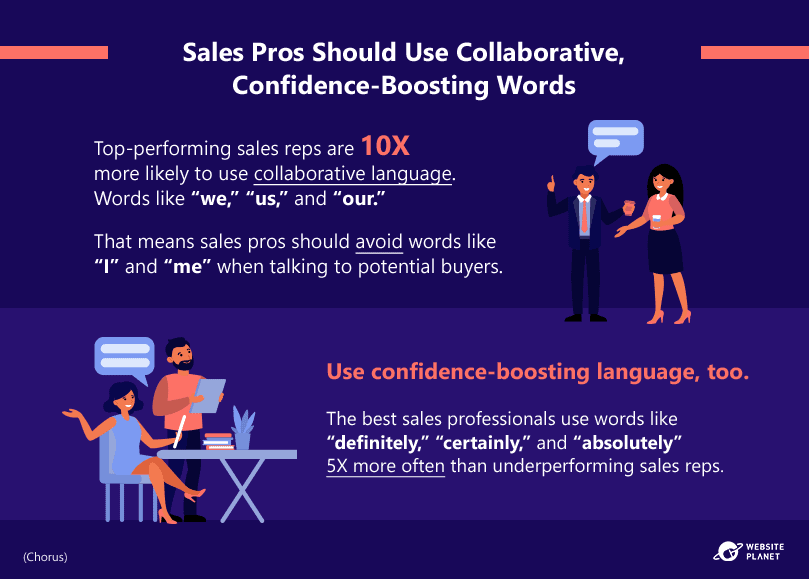 Another study analyzed the language that works for the very best sales professionals. Top-performers boost customer confidence with collaborative language and positive words.
Using words like “we” presents the salesperson’s business as professional while also signaling a collaborative effort to achieve the buyer’s goals.
Confidence-boosting words are persuasive, convincing a buyer that the deal is in the right hands.
Another study analyzed the language that works for the very best sales professionals. Top-performers boost customer confidence with collaborative language and positive words.
Using words like “we” presents the salesperson’s business as professional while also signaling a collaborative effort to achieve the buyer’s goals.
Confidence-boosting words are persuasive, convincing a buyer that the deal is in the right hands.
59. Be Optimistic
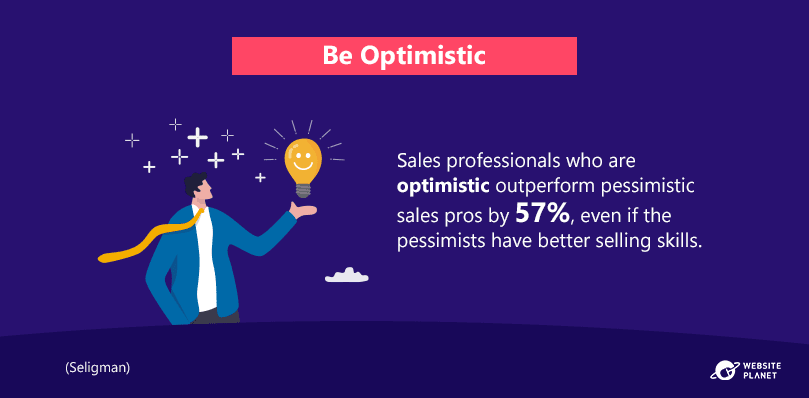 In general, it helps to have a positive outlook when pitching. Buyers will sense whether something is off if you’re not feeling 100%.
Prospecting can be a painfully drawn-out process, but doing your best to maintain face should see positive results in the end.
In general, it helps to have a positive outlook when pitching. Buyers will sense whether something is off if you’re not feeling 100%.
Prospecting can be a painfully drawn-out process, but doing your best to maintain face should see positive results in the end.
60. Follow Up Quickly
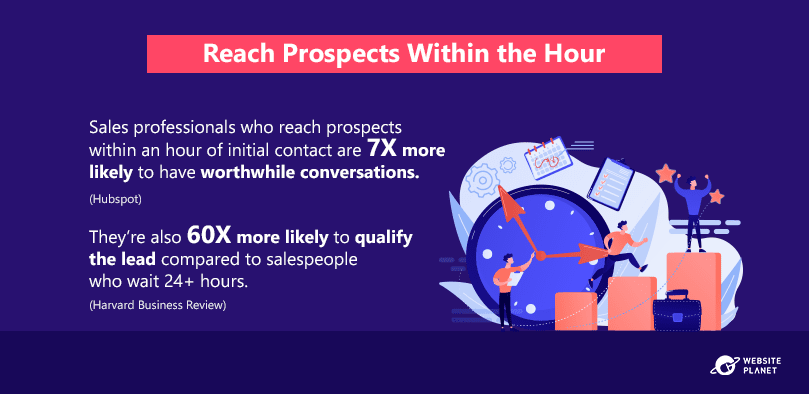 Sales professionals should follow up with leads quickly to maximize sales performance. Sales pros that get to leads within the hour see fantastic results.
Most buyers will actually stay loyal to the salesperson that reaches them first. 35-50% of all sales go to the first vendor to follow up on an inquiry or initial contact. Research suggests contacting a lead 5 minutes after their initial inquiry is optimal.
Sales professionals should follow up with leads quickly to maximize sales performance. Sales pros that get to leads within the hour see fantastic results.
Most buyers will actually stay loyal to the salesperson that reaches them first. 35-50% of all sales go to the first vendor to follow up on an inquiry or initial contact. Research suggests contacting a lead 5 minutes after their initial inquiry is optimal.
61. Follow Up Persistently
 Follow up with dogged persistence. Most salespeople (66%) give up after just two follow-up attempts, yet the numbers show that it takes multiple follow-ups to close deals.
48% of sales professionals never even make a single follow-up attempt, which is criminal. These sales reps are missing out on tons of business!
The same goes for email follow-ups. 70% of sales professionals only send one follow-up email. Sales professionals can boost their chances of a reply by 25% if they send more.
Follow up with dogged persistence. Most salespeople (66%) give up after just two follow-up attempts, yet the numbers show that it takes multiple follow-ups to close deals.
48% of sales professionals never even make a single follow-up attempt, which is criminal. These sales reps are missing out on tons of business!
The same goes for email follow-ups. 70% of sales professionals only send one follow-up email. Sales professionals can boost their chances of a reply by 25% if they send more.
62. Referrals Generate Quality Leads
 Referrals are perfect for any business. They’re like a form of word-of-mouth marketing where customers sell your products at no extra cost to yourself.
Not literally, of course, but customers spread positive brand awareness when they refer friends and family, which leads to sales down the line.
In Hubspot’s survey, marketers rated referrals as the best way to get quality leads.
Perhaps the reason is that customers trust their friends more than they trust any salesperson or marketer. 92% of people say they trust referrals from friends more than traditional advertisements (Nielsen).
This added element of trust causes high close rates for referred customers. People are 4X more likely to buy when they receive a recommendation from a friend. They’re also 37% more likely to become a repeat customer (Deloitte).
Referrals are perfect for any business. They’re like a form of word-of-mouth marketing where customers sell your products at no extra cost to yourself.
Not literally, of course, but customers spread positive brand awareness when they refer friends and family, which leads to sales down the line.
In Hubspot’s survey, marketers rated referrals as the best way to get quality leads.
Perhaps the reason is that customers trust their friends more than they trust any salesperson or marketer. 92% of people say they trust referrals from friends more than traditional advertisements (Nielsen).
This added element of trust causes high close rates for referred customers. People are 4X more likely to buy when they receive a recommendation from a friend. They’re also 37% more likely to become a repeat customer (Deloitte).
63. Always Ask For Referrals
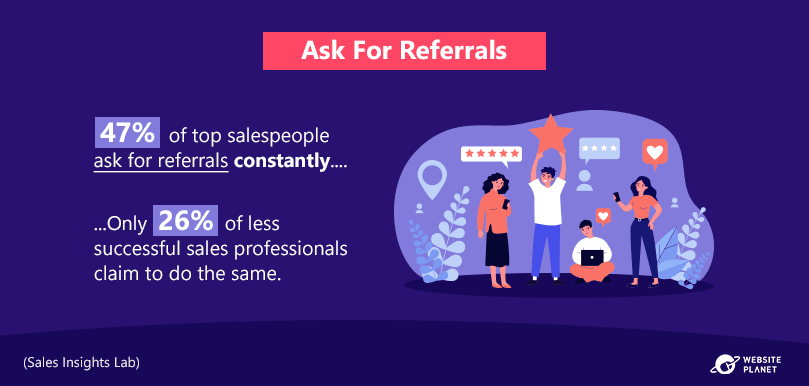 How do you go about getting referrals? The answer to that question is pretty straightforward: ask for them!
Once the deal is closed, ask customers if they would consider recommending your business. If they’ve had a satisfactory experience, they won’t think twice about telling their friends.
Businesses can also create customer referral templates to send to customers via email. These ask for referrals using polite, professional language.
How do you go about getting referrals? The answer to that question is pretty straightforward: ask for them!
Once the deal is closed, ask customers if they would consider recommending your business. If they’ve had a satisfactory experience, they won’t think twice about telling their friends.
Businesses can also create customer referral templates to send to customers via email. These ask for referrals using polite, professional language.
64. The Challenges of Closing the Deal
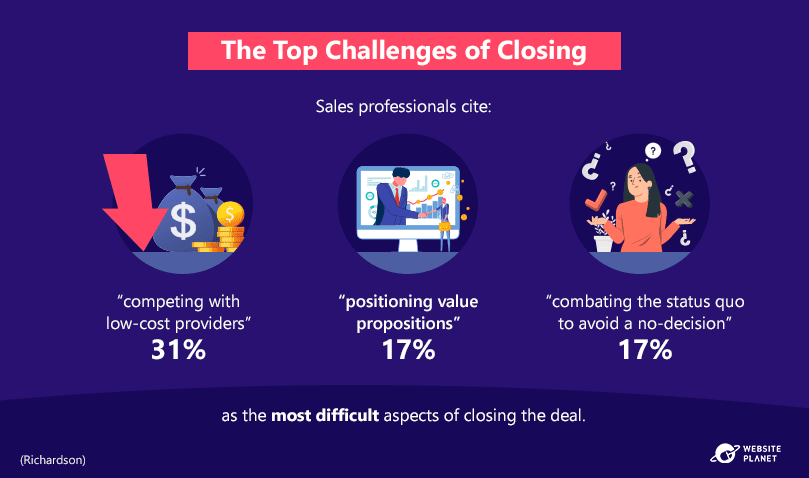 Sales professionals experience some specific difficulties when trying to “close the deal.”
Contentions over price are the most significant sticking point. Competitors can undercut sales teams with super-low offers, leaving sales pros with nowhere to go when discussing pricing.
Positioning value propositions is another challenge for sales pros, while combating the status quo was the third biggest obstacle.
Sales professionals experience some specific difficulties when trying to “close the deal.”
Contentions over price are the most significant sticking point. Competitors can undercut sales teams with super-low offers, leaving sales pros with nowhere to go when discussing pricing.
Positioning value propositions is another challenge for sales pros, while combating the status quo was the third biggest obstacle.
Sales Mediums, Channels, And Types
Salespeople conduct different types of selling through various channels and mediums of communication. Each type of sale serves a different purpose and targets customers in alternative ways.65. Which Communication Channels Are Best?
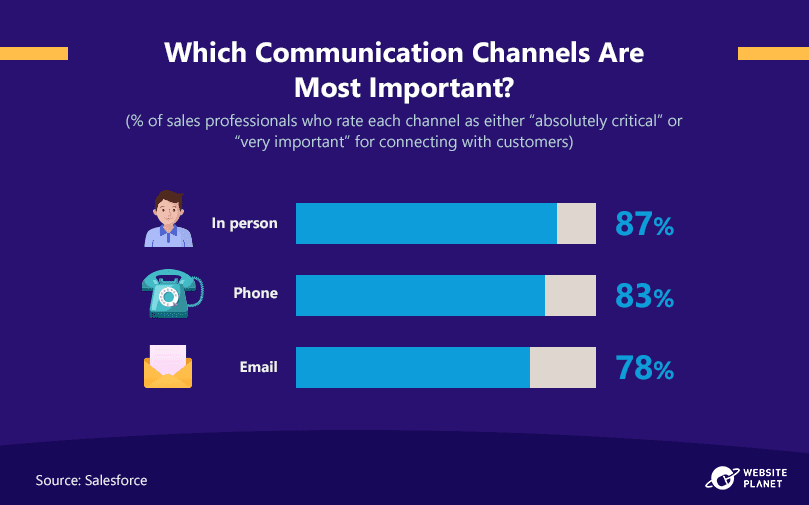 In-person interaction is still the essential communication channel for sales professionals. Despite huge improvements/increases in online forms of communication, nothing can entirely replace face-to-face interaction.
Sales professionals are more persuasive and attentive when dealing with customers in person. Buyers prefer face-to-face interactions as well. 86% of customers would like to ask questions in person.
Phone and email are the 2 other vital channels of communication for sales reps. Sales pros use phones for prospecting and liaising with all manner of clients, and email is another popular medium for the prospecting/follow-up process.
In-person interaction is still the essential communication channel for sales professionals. Despite huge improvements/increases in online forms of communication, nothing can entirely replace face-to-face interaction.
Sales professionals are more persuasive and attentive when dealing with customers in person. Buyers prefer face-to-face interactions as well. 86% of customers would like to ask questions in person.
Phone and email are the 2 other vital channels of communication for sales reps. Sales pros use phones for prospecting and liaising with all manner of clients, and email is another popular medium for the prospecting/follow-up process.
66. The Online World of Sales
 Although in-person interactions are still the most effective way for sales professionals to connect with clients and customers, online selling has seen huge growth in recent times. This growth will continue long into the future.
Shoppers are now extremely confident making purchasing decisions online. More than 255 million Americans shop online. That’s around 88% of the US adult population, and the figure will swell to nearly 280 million US online shoppers by 2024.
B2C retail is not the only sector adopting eCommerce at a vast rate. 65% of B2B businesses say they will invest in eCommerce over the next couple of years, with online sales expected to account for more than 50% of B2B business by 2023 (Salesforce).
Although in-person interactions are still the most effective way for sales professionals to connect with clients and customers, online selling has seen huge growth in recent times. This growth will continue long into the future.
Shoppers are now extremely confident making purchasing decisions online. More than 255 million Americans shop online. That’s around 88% of the US adult population, and the figure will swell to nearly 280 million US online shoppers by 2024.
B2C retail is not the only sector adopting eCommerce at a vast rate. 65% of B2B businesses say they will invest in eCommerce over the next couple of years, with online sales expected to account for more than 50% of B2B business by 2023 (Salesforce).
67. COVID-19 Has Driven Low-Contact Sales
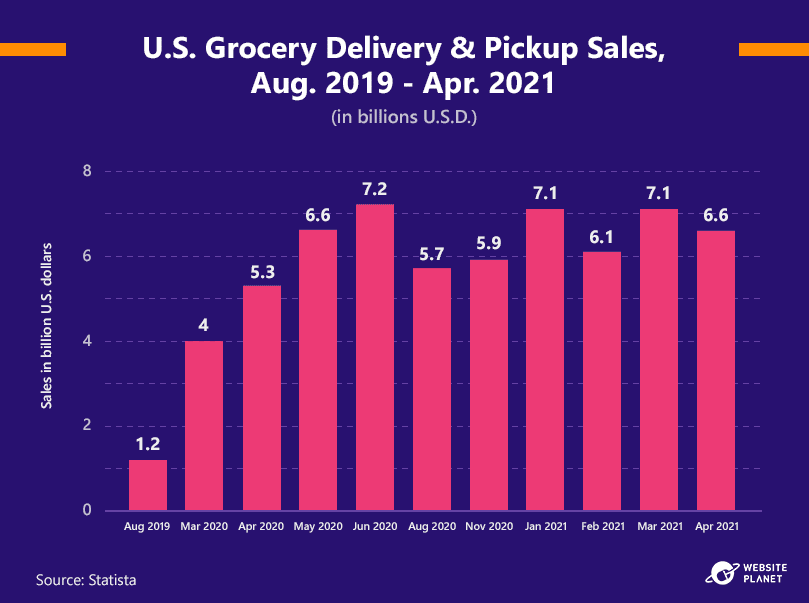 Rapid growth in the food delivery market is a perfect example of how COVID-19 is changing the sales landscape.
The US grocery delivery market jumped from a $1.2bn valuation in August 2019 to $7.2bn in June 2020. The market’s valuation remains high, even as vaccinations curb the spread of the COVID-19 pandemic.
The change represents a shift in the mindset of customers and buyers. People now value online sales and low-contact methods of interaction. For many people, the anxieties around face-to-face sales (and the preference towards online methods) will never change.
Rapid growth in the food delivery market is a perfect example of how COVID-19 is changing the sales landscape.
The US grocery delivery market jumped from a $1.2bn valuation in August 2019 to $7.2bn in June 2020. The market’s valuation remains high, even as vaccinations curb the spread of the COVID-19 pandemic.
The change represents a shift in the mindset of customers and buyers. People now value online sales and low-contact methods of interaction. For many people, the anxieties around face-to-face sales (and the preference towards online methods) will never change.
68. Inside Sales Growth
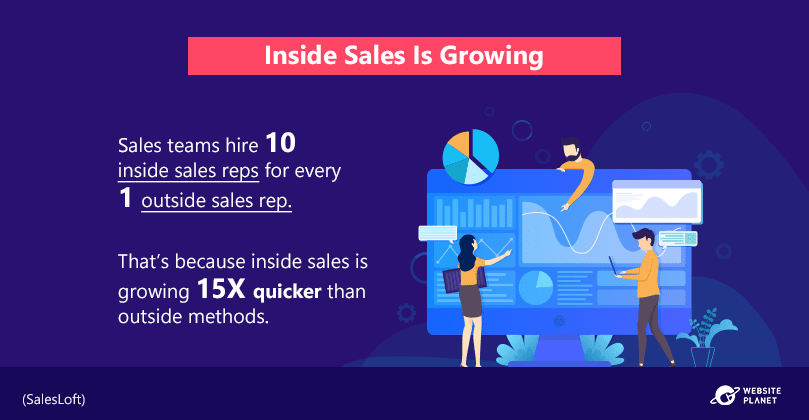 Inside sales have taken precedence as buyers and sellers turn to online methods during COVID-19.
Online growth and the rise of eCommerce are also playing their part in a shift towards digital selling methods. Inside sales reps are getting hired far more than outside sales reps, and inside growth is outpacing outside sales more generally.
In-person sales will bounce back, though the efficiency of inside methods is another indication that inside divisions shall continue to expand. Inside teams pay between 40% and 90% less than outside teams when acquiring new customers.
Inside sales have taken precedence as buyers and sellers turn to online methods during COVID-19.
Online growth and the rise of eCommerce are also playing their part in a shift towards digital selling methods. Inside sales reps are getting hired far more than outside sales reps, and inside growth is outpacing outside sales more generally.
In-person sales will bounce back, though the efficiency of inside methods is another indication that inside divisions shall continue to expand. Inside teams pay between 40% and 90% less than outside teams when acquiring new customers.
*69. Virtual Channels Drive Revenue During COVID-19
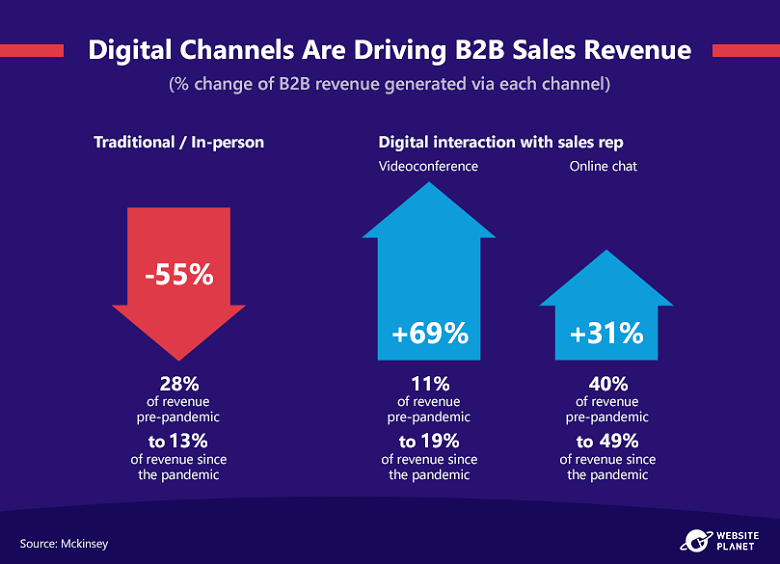 Despite the importance of in-person interactions for sales teams, COVID-19 has increased the prevalence of digital modes of communication.
57% of sales professionals say they are making more calls than before the pandemic. 51% of sales professionals are sending more emails, and 77% hold more video meetings (LinkedIn).
Teams now use online chats and video meetings as part of the sales process far more often, and these 2 channels are driving sales revenue. B2B sales revenue from in-person interaction has fallen from 28% to 13%, a 55% decrease. Meanwhile, 11% of revenue came through video conferencing meetings before the COVID-19 pandemic. That figure is now 19%, a 69% increase, while online chat revenue has increased by 31%.
Despite the importance of in-person interactions for sales teams, COVID-19 has increased the prevalence of digital modes of communication.
57% of sales professionals say they are making more calls than before the pandemic. 51% of sales professionals are sending more emails, and 77% hold more video meetings (LinkedIn).
Teams now use online chats and video meetings as part of the sales process far more often, and these 2 channels are driving sales revenue. B2B sales revenue from in-person interaction has fallen from 28% to 13%, a 55% decrease. Meanwhile, 11% of revenue came through video conferencing meetings before the COVID-19 pandemic. That figure is now 19%, a 69% increase, while online chat revenue has increased by 31%.
70. The Impact of Social Sales
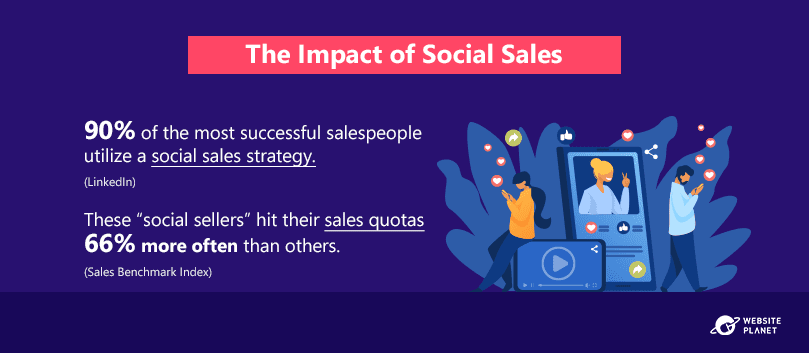 Social sales is an area of digital sales that’s come to the fore as social media platforms continue to cultivate humongous user bases.
More than half of salespeople say they can track closed deals back to social media (Jim Keenan Study). Sales professionals are primarily using social sales to gather leads. Over 70% rank “customer acquisition” as their number one social sales priority.
Social platforms provide several advantages to salespeople trying to collect high-quality leads. For a start, people tend to spend 20-30% more money when they interact with a brand through social media.
Social selling is also far less time-consuming than other forms of prospecting. More than half of sales professionals spend less than 10% of their time social selling (Zety).
Social sales is an area of digital sales that’s come to the fore as social media platforms continue to cultivate humongous user bases.
More than half of salespeople say they can track closed deals back to social media (Jim Keenan Study). Sales professionals are primarily using social sales to gather leads. Over 70% rank “customer acquisition” as their number one social sales priority.
Social platforms provide several advantages to salespeople trying to collect high-quality leads. For a start, people tend to spend 20-30% more money when they interact with a brand through social media.
Social selling is also far less time-consuming than other forms of prospecting. More than half of sales professionals spend less than 10% of their time social selling (Zety).
71. The Benefits of Social Sales
 Social sales has some very useful benefits. In the current sales climate, some of these benefits take on added significance.
Chiefly amongst these is “reduced contact time.” Social selling speeds up prospecting and reduces the need for in-person interactions that customers may find anxiety-inducing.
Sales pros who use social methods also generate more leads in less time, while, interestingly, social platforms also foster deeper client-customer relations than other prospecting methods.
Social sales has some very useful benefits. In the current sales climate, some of these benefits take on added significance.
Chiefly amongst these is “reduced contact time.” Social selling speeds up prospecting and reduces the need for in-person interactions that customers may find anxiety-inducing.
Sales pros who use social methods also generate more leads in less time, while, interestingly, social platforms also foster deeper client-customer relations than other prospecting methods.
72. The Social Selling Tool of Choice
 LinkedIn is the biggest social media platform for sales professionals, and its social selling tools are the most popular options available to salespeople.
74% of sales professionals either use LinkedIn.com, LinkedIn Premium, or the LinkedIn Sales Navigator. The platform offers sales professionals the opportunity to network with other businesses and potential leads.
Owing to the platform’s impact, top-performers are networking on LinkedIn more than others — and they’re using its Sales Navigator more often too.
LinkedIn is the biggest social media platform for sales professionals, and its social selling tools are the most popular options available to salespeople.
74% of sales professionals either use LinkedIn.com, LinkedIn Premium, or the LinkedIn Sales Navigator. The platform offers sales professionals the opportunity to network with other businesses and potential leads.
Owing to the platform’s impact, top-performers are networking on LinkedIn more than others — and they’re using its Sales Navigator more often too.
73. Prospect Through Email
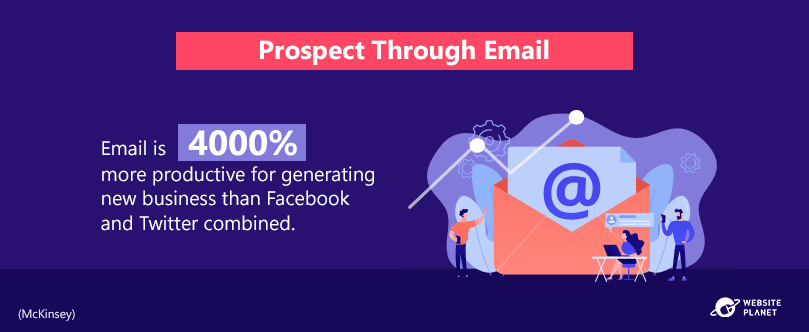 Sales professionals send an average of 36.2 emails every day (Sales for Life). They rely on email because it’s an effective way to communicate with colleagues and clients alike.
Email is also a great way to prospect. Despite the rise of social selling, email is far more effective than Facebook and Twitter combined.
Research suggests sales professionals should even send prospecting emails instead of cold calls. Cold-emailing offers twice the return-on-investment as cold calling methods.
Sales professionals send an average of 36.2 emails every day (Sales for Life). They rely on email because it’s an effective way to communicate with colleagues and clients alike.
Email is also a great way to prospect. Despite the rise of social selling, email is far more effective than Facebook and Twitter combined.
Research suggests sales professionals should even send prospecting emails instead of cold calls. Cold-emailing offers twice the return-on-investment as cold calling methods.
74. Personalize Your Emails
 Sales professionals should be wary of sending emails in bulk. These will likely land in the spam folder of your prospects’ email inbox. In fact, 95% of sales professionals believe bulk emailing (sending the same generic email to everyone) is ineffective (RainGroup).
Instead, sales professionals should opt to personalize any email messages they send. Even something as simple as a recipient name will boost open rates and conversions.
Sales professionals should be wary of sending emails in bulk. These will likely land in the spam folder of your prospects’ email inbox. In fact, 95% of sales professionals believe bulk emailing (sending the same generic email to everyone) is ineffective (RainGroup).
Instead, sales professionals should opt to personalize any email messages they send. Even something as simple as a recipient name will boost open rates and conversions.
75. Online Sales Challenges
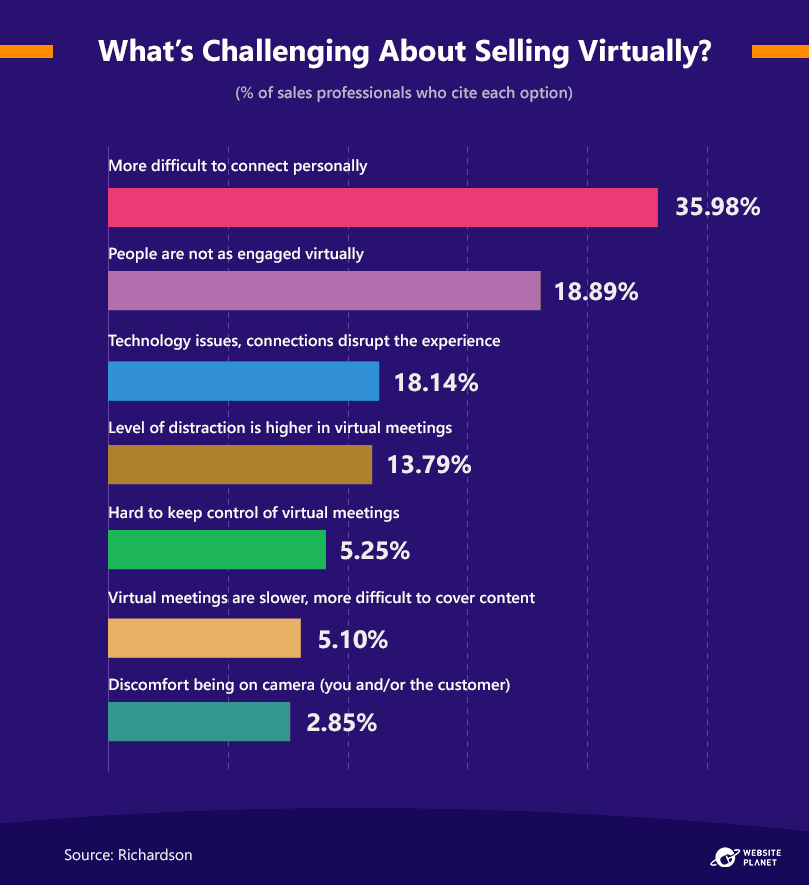 Sales professionals highlight the virtual sales challenges they expect to face on a daily basis.
Making personal connections with customers is the biggest virtual sales challenge. In-person interactions are the best way to forge a personal connection with customers, and it can be harder to “get to know” customers via online channels.
It’s more difficult to hold someone’s attention online as well. Clients can become disengaged or distracted, and virtual meetings can be hard to control.
Sales professionals are also at the mercy of the devices they use. 18% of sales professionals rate technology issues as a challenge.
Sales professionals highlight the virtual sales challenges they expect to face on a daily basis.
Making personal connections with customers is the biggest virtual sales challenge. In-person interactions are the best way to forge a personal connection with customers, and it can be harder to “get to know” customers via online channels.
It’s more difficult to hold someone’s attention online as well. Clients can become disengaged or distracted, and virtual meetings can be hard to control.
Sales professionals are also at the mercy of the devices they use. 18% of sales professionals rate technology issues as a challenge.
76. Direct Sales: Industries & Products
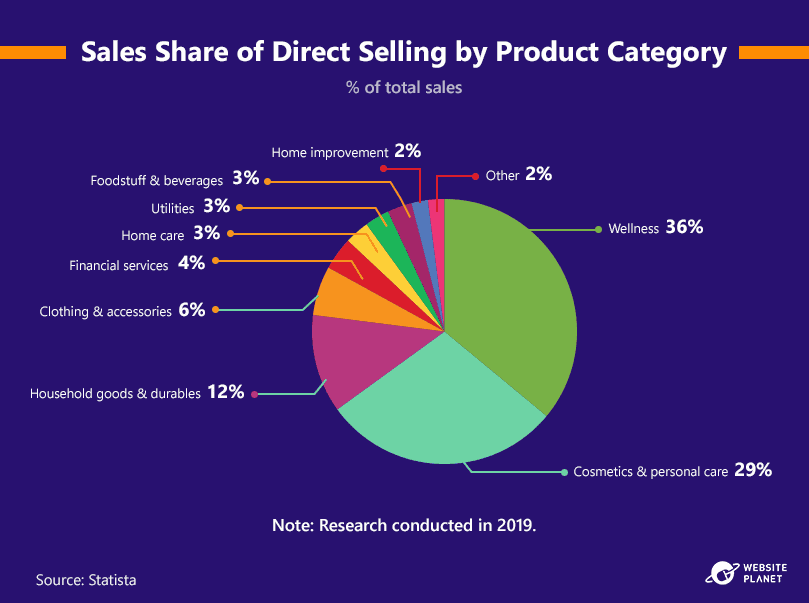 As mentioned, direct sales have taken a hit in recent years, though some industries still benefit from direct sales methods.
In particular, brands with products of high value that require a test/demo lend themselves well to direct sales.
I’m sure we’re all familiar with beauty and cosmetics sales agents, who often visit customers’ houses to demonstrate cosmetics products. Similarly, wellness products give sales representatives opportunities to provide expertise and advice based on each customer.
Household goods, such as hoovers and kitchen appliances, are also popular amongst direct sellers.
As mentioned, direct sales have taken a hit in recent years, though some industries still benefit from direct sales methods.
In particular, brands with products of high value that require a test/demo lend themselves well to direct sales.
I’m sure we’re all familiar with beauty and cosmetics sales agents, who often visit customers’ houses to demonstrate cosmetics products. Similarly, wellness products give sales representatives opportunities to provide expertise and advice based on each customer.
Household goods, such as hoovers and kitchen appliances, are also popular amongst direct sellers.
77. Door-To-Door Selling Is Hard Work
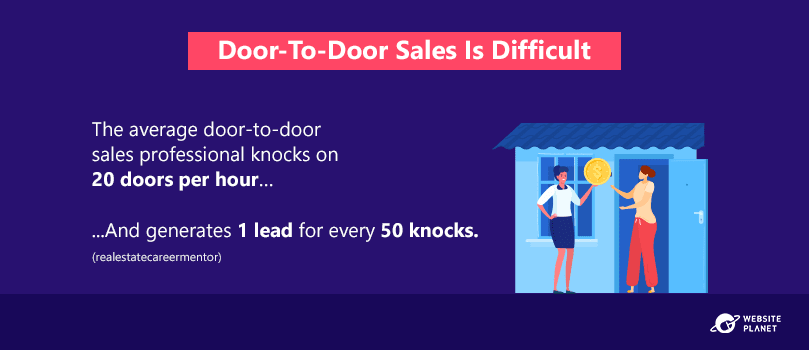 Door-to-door sales is one of the most well-known methods of direct selling. Door-to-door salespeople certainly had their heyday in the 20th century. Today, door-to-door sales requires a lot of hard work for fewer leads and sales than inside methods.
D2D salespeople knock on around 20 doors an hour and generate one lead for every 50 doors they knock on. That’s a single lead per 2-2.5 hours of work, and not all of these leads are likely to convert.
Customers are even less likely to entertain a door-to-door sales pitch during the anxieties of a pandemic. The practice’s low success rates mean door-to-door products need to be of high value to return an investment.
Door-to-door sales is one of the most well-known methods of direct selling. Door-to-door salespeople certainly had their heyday in the 20th century. Today, door-to-door sales requires a lot of hard work for fewer leads and sales than inside methods.
D2D salespeople knock on around 20 doors an hour and generate one lead for every 50 doors they knock on. That’s a single lead per 2-2.5 hours of work, and not all of these leads are likely to convert.
Customers are even less likely to entertain a door-to-door sales pitch during the anxieties of a pandemic. The practice’s low success rates mean door-to-door products need to be of high value to return an investment.
78. Door-To-Door Sales Technique
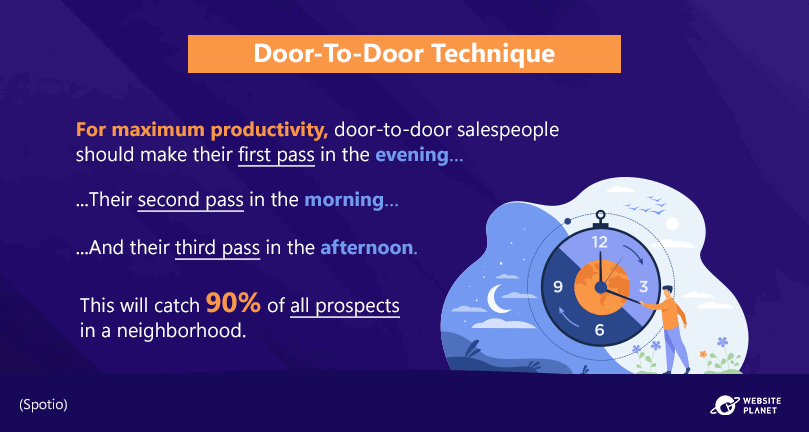 Door-to-door sales professionals need a contact rate of 30-40% to be successful (Spotio), in which case, D2D salespeople should focus on maximizing the number of doors they knock.
3 passes in a neighborhood is considered optimal for door-to-door professionals. Salespeople should focus on making their first pass in the evening. This is the peak time for knocking on doors, as it’s the time most people will be home from work.
Return in the morning and again in the afternoon to engage most people in the area. You’re accounting for differences in people’s schedules by knocking on doors in this way.
Once you’ve secured a few leads, make sure you send a confirmatory text. Texting a new contact can boost conversion rates by 112%.
Door-to-door sales professionals need a contact rate of 30-40% to be successful (Spotio), in which case, D2D salespeople should focus on maximizing the number of doors they knock.
3 passes in a neighborhood is considered optimal for door-to-door professionals. Salespeople should focus on making their first pass in the evening. This is the peak time for knocking on doors, as it’s the time most people will be home from work.
Return in the morning and again in the afternoon to engage most people in the area. You’re accounting for differences in people’s schedules by knocking on doors in this way.
Once you’ve secured a few leads, make sure you send a confirmatory text. Texting a new contact can boost conversion rates by 112%.
79. Cold Calling Is a Long Process
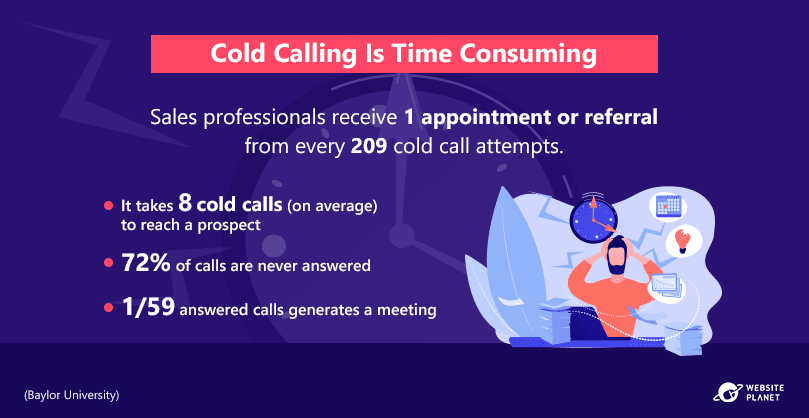 Like the former, cold calling can be a long process that requires patience to achieve results.
Just 28% of sales professionals think cold calling is effective (RainGroup). It can take hundreds of calls to get an appointment, and even then, a lead may not convert into a sale.
Cold calling requires steely determination to get the job done. It can take multiple calls to reach a prospect (similar to other forms of prospecting). To be clear, most salespeople prefer different methods, which is why 63% of salespeople hate cold calling more than any other aspect of their job.
Like the former, cold calling can be a long process that requires patience to achieve results.
Just 28% of sales professionals think cold calling is effective (RainGroup). It can take hundreds of calls to get an appointment, and even then, a lead may not convert into a sale.
Cold calling requires steely determination to get the job done. It can take multiple calls to reach a prospect (similar to other forms of prospecting). To be clear, most salespeople prefer different methods, which is why 63% of salespeople hate cold calling more than any other aspect of their job.
80. Best Time (& Day) to Make a Sales Call
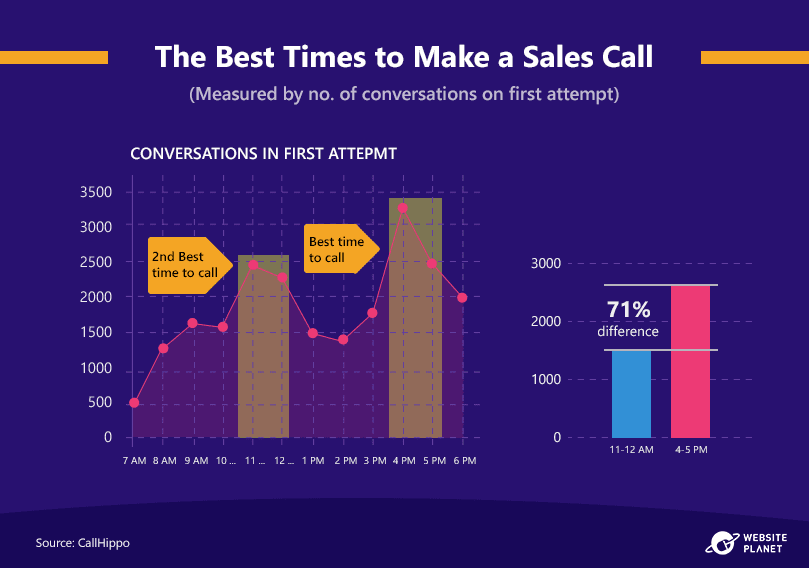 Unfortunately for many people working in sales, cold calling is still a part of the job. The average inside sales rep makes 33 cold calls a day (ForEntrepreneurs and The Bridge Group). More cold calling conversations correlate to better quota attainment, so improving the overall efficiency of the process is important.
Calling at the most effective times of the day should help improve efficiency.
CallHippo found that the best times to cold call are just before lunch and before the end of the working day. 10:30am to 12am is the first period cold-callers should aim for. Calling between 3:30pm and 5:15pm returns the highest number of conversations.
The study shows that people are more receptive when finishing their tasks before a break. The same report also discovered that Wednesdays and Thursdays were the best days of the week to call, while calls on Mondays and Fridays are answered less often. Calls on Wednesdays create 46% more conversations than calls on Monday.
Unfortunately for many people working in sales, cold calling is still a part of the job. The average inside sales rep makes 33 cold calls a day (ForEntrepreneurs and The Bridge Group). More cold calling conversations correlate to better quota attainment, so improving the overall efficiency of the process is important.
Calling at the most effective times of the day should help improve efficiency.
CallHippo found that the best times to cold call are just before lunch and before the end of the working day. 10:30am to 12am is the first period cold-callers should aim for. Calling between 3:30pm and 5:15pm returns the highest number of conversations.
The study shows that people are more receptive when finishing their tasks before a break. The same report also discovered that Wednesdays and Thursdays were the best days of the week to call, while calls on Mondays and Fridays are answered less often. Calls on Wednesdays create 46% more conversations than calls on Monday.
Emerging Technologies In Sales
Growth in sales teams has been driven by the emergence of new technologies over the last couple of years. Sales teams can now organize and strategize their efforts through AI, sales tools, and automated processes. Here are the stats behind emerging sales technologies.81. Sales Technology Is Important
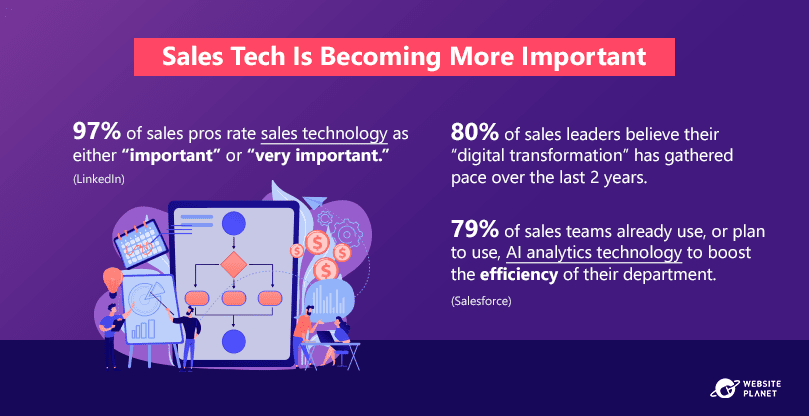 Sales technologies have experienced universal adoption over the last few years. Sales teams that don’t implement big changes are now being left in the dust.
As top-performers leverage technology to improve efficiency, sales
81% of sales professionals say that technology needs have changed since 2019. Another 81% say that they can now implement changes faster than ever before.
Technology is having a massive impact on the sales world. These measurable benefits explain why sales organizations are now spending more on tech than they ever have before.
Sales technologies have experienced universal adoption over the last few years. Sales teams that don’t implement big changes are now being left in the dust.
As top-performers leverage technology to improve efficiency, sales
81% of sales professionals say that technology needs have changed since 2019. Another 81% say that they can now implement changes faster than ever before.
Technology is having a massive impact on the sales world. These measurable benefits explain why sales organizations are now spending more on tech than they ever have before.
82. Guided Selling Is Essential
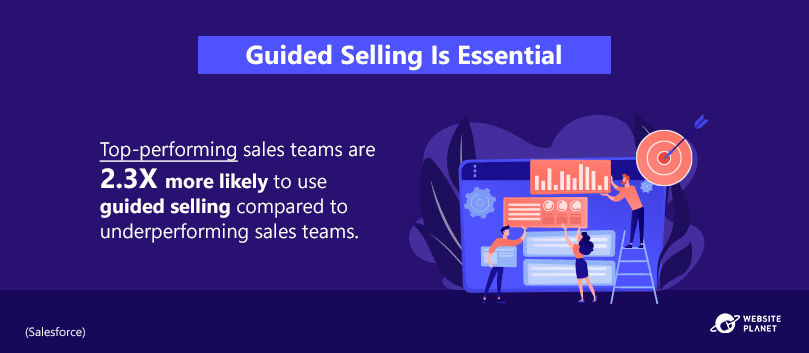 Guided selling is not a specific technology, rather a process. It’s the practice of using technology (AI and machine learning) to deliver insights that aid the selling process, all of which are anchored and displayed through CRM software.
Companies that use guided selling can deliver better, faster, and more decisive sales services to customers. Guided selling is fast becoming a central sales process in businesses. Adoption in sales teams is expected to grow 98% over the next few years (Salesforce).
Guided selling is not a specific technology, rather a process. It’s the practice of using technology (AI and machine learning) to deliver insights that aid the selling process, all of which are anchored and displayed through CRM software.
Companies that use guided selling can deliver better, faster, and more decisive sales services to customers. Guided selling is fast becoming a central sales process in businesses. Adoption in sales teams is expected to grow 98% over the next few years (Salesforce).
83. Top 5 Emerging Sales Tools
 Video conferencing is the number one emerging tech tool in sales. Video conferencing allows sales professionals to meet with distant clients. It also offers remote sales teams an opportunity to report progress with their managers. Video conferencing can even be used in the sales training process.
Artificial Intelligence has experienced the second-largest level of adoption in the last two years. Although, by all accounts, AI is the most important sales technology.
AI helps sales pros collect data, forecast, analyze, and personalize customer experiences.
Video conferencing is the number one emerging tech tool in sales. Video conferencing allows sales professionals to meet with distant clients. It also offers remote sales teams an opportunity to report progress with their managers. Video conferencing can even be used in the sales training process.
Artificial Intelligence has experienced the second-largest level of adoption in the last two years. Although, by all accounts, AI is the most important sales technology.
AI helps sales pros collect data, forecast, analyze, and personalize customer experiences.
84. AI Is the Key Driver
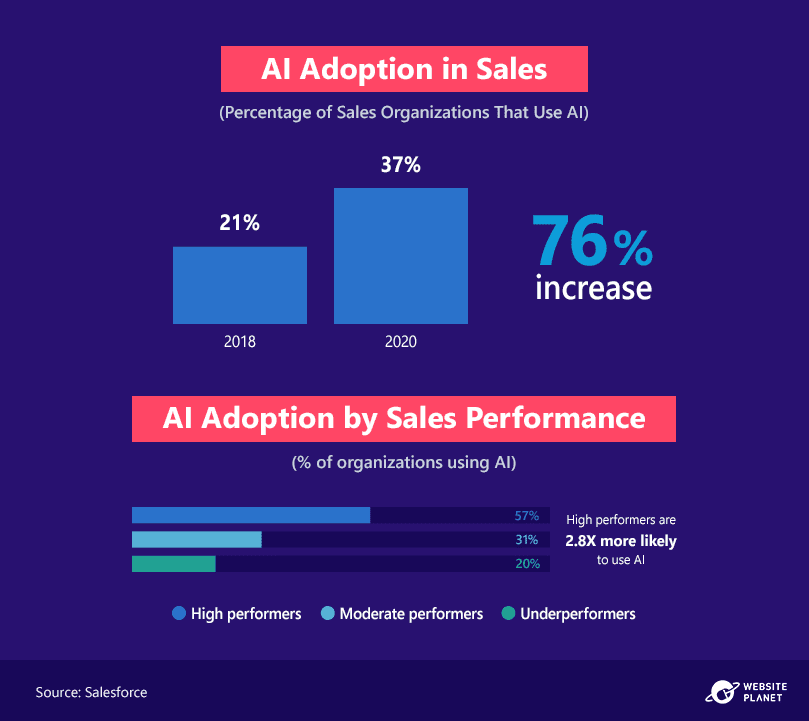 AI is the key driver of growth in sales teams, used by 37% of sales teams. What’s more, AI adoption is much more common among top-performing sales organizations. 57% of the best sales teams use AI, compared to just 20% of underperformers.
AI adoption is expected to continue its growth trajectory. Between 2019 and 2022, AI adoption will increase by 139% in sales teams.
AI is the key driver of growth in sales teams, used by 37% of sales teams. What’s more, AI adoption is much more common among top-performing sales organizations. 57% of the best sales teams use AI, compared to just 20% of underperformers.
AI adoption is expected to continue its growth trajectory. Between 2019 and 2022, AI adoption will increase by 139% in sales teams.
85. The Benefits of AI In Sales
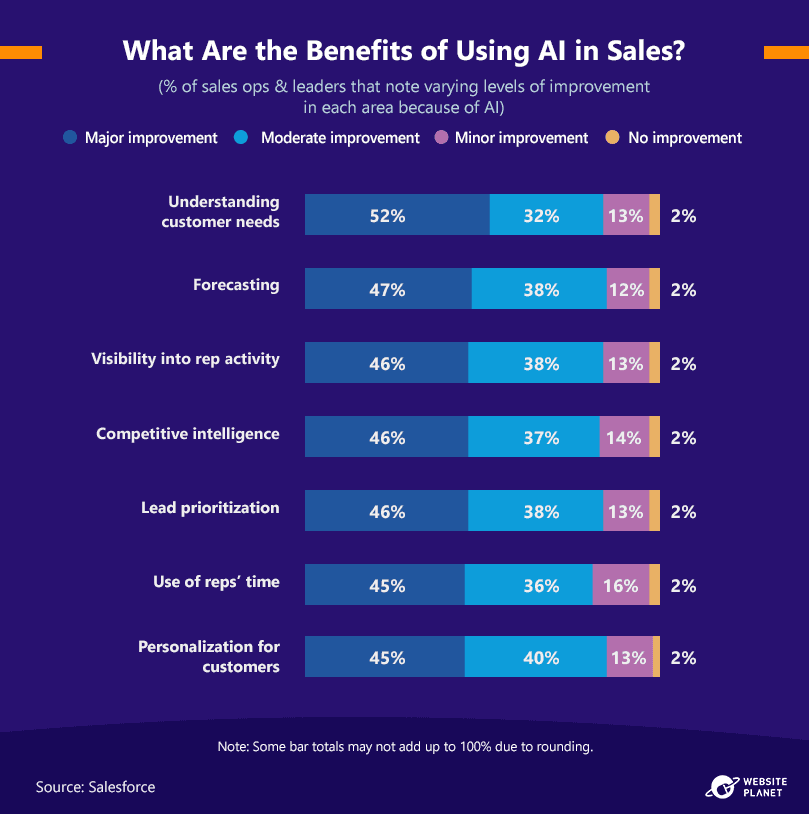 AI is crucial to sales success because it impacts so many different levels. Primarily, AI helps sales teams collect and understand data and customer insights.
We’ve established that customers want salespeople to understand the ins and outs of their business, goals, and needs. AI analytics massively improves a sales team’s ability to gauge customer needs.
Better forecasting is another upside of sales AI. Top-performing sales teams are 10.5X more likely to get major improvements to forecast accuracy from AI compared to underperforming teams (salesforce).
Businesses are using AI to monitor sales reps, too, which can improve sales performance down the line.
AI is crucial to sales success because it impacts so many different levels. Primarily, AI helps sales teams collect and understand data and customer insights.
We’ve established that customers want salespeople to understand the ins and outs of their business, goals, and needs. AI analytics massively improves a sales team’s ability to gauge customer needs.
Better forecasting is another upside of sales AI. Top-performing sales teams are 10.5X more likely to get major improvements to forecast accuracy from AI compared to underperforming teams (salesforce).
Businesses are using AI to monitor sales reps, too, which can improve sales performance down the line.
86. AI for Lead Generation
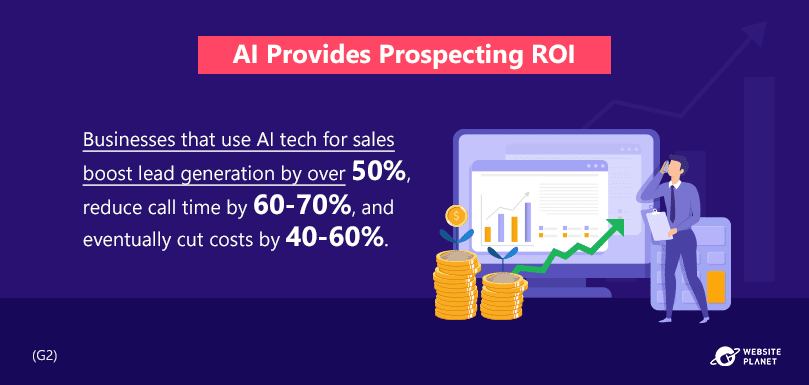 AI and machine learning technologies can help sales teams filter insights and prioritize leads.
Prioritizing better leads means sales professionals don’t waste time cold calling hundreds of prospects. What’s more, the calls they do make have a higher chance of becoming leads.
This improves ROI and efficiency across the board, with less time spent ringing dud prospects and more time spent closing deals.
AI and machine learning technologies can help sales teams filter insights and prioritize leads.
Prioritizing better leads means sales professionals don’t waste time cold calling hundreds of prospects. What’s more, the calls they do make have a higher chance of becoming leads.
This improves ROI and efficiency across the board, with less time spent ringing dud prospects and more time spent closing deals.
87. Automate Menial Tasks
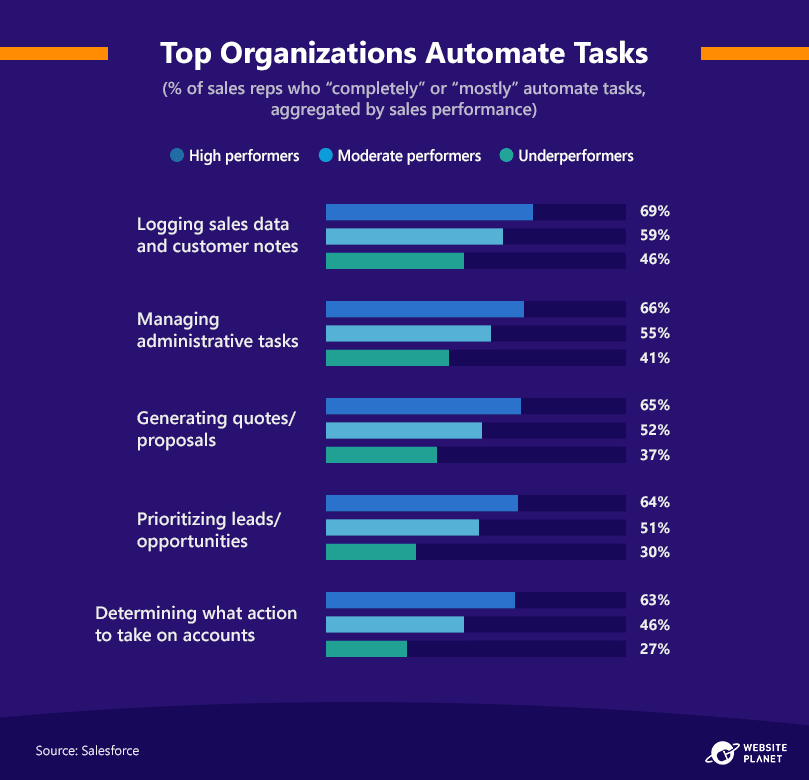 Automating tasks through technology means sales teams spend less time on menial tasks, and more time focusing on what’s important: selling.
Top-sellers generally automate tasks more often than underperformers. Data entry is the number one automated task. 27% of sales professionals waste over an hour of their time on data entry every day (Hubspot), so it is essential to streamline this process.
Sales teams also automate admin tasks, quote generation, and lead prioritization. Top-performers even automate decision-making responsibilities, and they do this 1.3X more often than underperformers.
Marketing automation technology adoption is expected to continue. The marketing automation industry will grow at 19.2% per year until 2025. In other words, automation isn’t going anywhere.
Automating tasks through technology means sales teams spend less time on menial tasks, and more time focusing on what’s important: selling.
Top-sellers generally automate tasks more often than underperformers. Data entry is the number one automated task. 27% of sales professionals waste over an hour of their time on data entry every day (Hubspot), so it is essential to streamline this process.
Sales teams also automate admin tasks, quote generation, and lead prioritization. Top-performers even automate decision-making responsibilities, and they do this 1.3X more often than underperformers.
Marketing automation technology adoption is expected to continue. The marketing automation industry will grow at 19.2% per year until 2025. In other words, automation isn’t going anywhere.
88. A Connected View of Data
 Make sure you can collect and view customer data for every stage of the buyer’s journey. This is ultimately going to help you get deals over the line.
Having a “connected view” of your customers’ relationship with your brand (often through interconnected data sources) will help you provide the best customer experience at every stage of the interaction.
Whether that means personalizing messages or feeding them the right information at the right time, knowing your customers enough to streamline the buyer journey will see results.
CRM tools are a great way to get this “connected view” of customer data.
Make sure you can collect and view customer data for every stage of the buyer’s journey. This is ultimately going to help you get deals over the line.
Having a “connected view” of your customers’ relationship with your brand (often through interconnected data sources) will help you provide the best customer experience at every stage of the interaction.
Whether that means personalizing messages or feeding them the right information at the right time, knowing your customers enough to streamline the buyer journey will see results.
CRM tools are a great way to get this “connected view” of customer data.
89. CRM Adoption In Sales
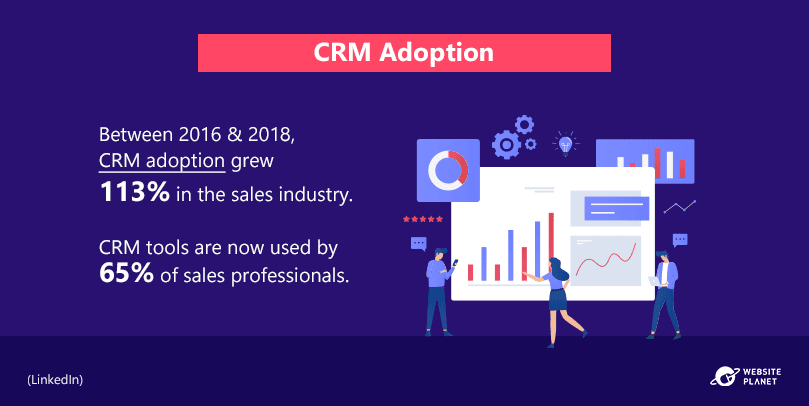 “CRM” stands for customer relationship management software. CRMs are technologies used to manage/monitor customers and leads across every stage of the buying journey. CRMs automate specific tasks to improve the efficiency of sales teams and the effectiveness of customer relationships.
CRMs are used by the majority of sales teams. The CRM software market is the fastest-growing software market in the world. It’s expected to grow 12.1% per year, reaching $85.8 billion in 2024.
“CRM” stands for customer relationship management software. CRMs are technologies used to manage/monitor customers and leads across every stage of the buying journey. CRMs automate specific tasks to improve the efficiency of sales teams and the effectiveness of customer relationships.
CRMs are used by the majority of sales teams. The CRM software market is the fastest-growing software market in the world. It’s expected to grow 12.1% per year, reaching $85.8 billion in 2024.
90. The Impact of CRMs
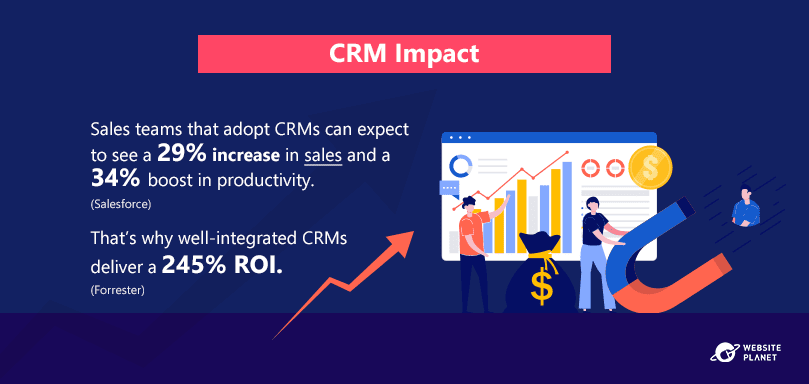 CRMs directly impact key performance metrics, leading to improvements in sales, productivity, and ROI.
50% of teams that implement well-integrated CRMs see significant advancements in productivity (Forrester). CRMs make customer data accessible and easy to understand. 74% of sales professionals believe CRMs provide better access to customer data (Software Advice).
CRMs directly impact key performance metrics, leading to improvements in sales, productivity, and ROI.
50% of teams that implement well-integrated CRMs see significant advancements in productivity (Forrester). CRMs make customer data accessible and easy to understand. 74% of sales professionals believe CRMs provide better access to customer data (Software Advice).
91. Collaboration Is Key
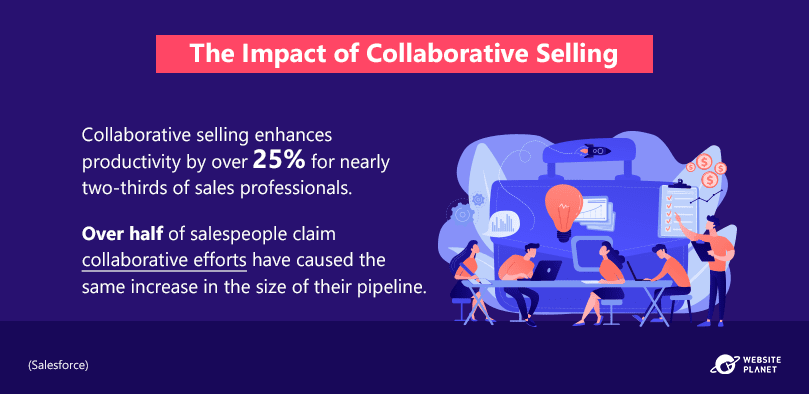 One practice that can improve the efficiency of the sales process is collaborative selling. Businesses with departments that collaborate to make sales see major improvements in productivity while growing the number of leads in their sales pipeline.
That’s why 77% of salespeople say collaborative selling is “important,” another 73% believe collaboration is either “critical” or “very important” to their sales success (Salesforce).
Collaborative selling is more common in top-performing sales teams — another sign of its impact. The best sales teams are 1.6X more likely to be alerted to sales opportunities by sales reps compared to other sales teams (Salesforce).
Collaborative selling teams can be organized through cross-functional workstream management technologies…
One practice that can improve the efficiency of the sales process is collaborative selling. Businesses with departments that collaborate to make sales see major improvements in productivity while growing the number of leads in their sales pipeline.
That’s why 77% of salespeople say collaborative selling is “important,” another 73% believe collaboration is either “critical” or “very important” to their sales success (Salesforce).
Collaborative selling is more common in top-performing sales teams — another sign of its impact. The best sales teams are 1.6X more likely to be alerted to sales opportunities by sales reps compared to other sales teams (Salesforce).
Collaborative selling teams can be organized through cross-functional workstream management technologies…
92. Sales Ops Are Using Workstream Management
 Cross-functional workstream management platforms (CFWMs) have seen significant adoption over the last year, as teams discover how useful they can be.
This is indeed one of the ways sales ops are becoming more involved in strategy and coordination. CFWMs allow sales ops to become a bridge between important contacts in different departments. This improves the efficiency of an organization as it improves collaboration.
The stats demonstrate the value of CFWM platforms. Top-performing sales teams are 2.3X more likely to have increased their use of CFWMs compared to underperforming sales teams.
Cross-functional workstream management platforms (CFWMs) have seen significant adoption over the last year, as teams discover how useful they can be.
This is indeed one of the ways sales ops are becoming more involved in strategy and coordination. CFWMs allow sales ops to become a bridge between important contacts in different departments. This improves the efficiency of an organization as it improves collaboration.
The stats demonstrate the value of CFWM platforms. Top-performing sales teams are 2.3X more likely to have increased their use of CFWMs compared to underperforming sales teams.
93. Contactless Payment Is Relevant
 Emerging sales technologies do not have to come in the form of AI software or management systems. Although contactless has been in use for a while now, one big change over the last two years has been the increased adoption of contactless payment methods.
Contactless was originally designed to optimize the buying process for customers. Since the onset of COVID-19, it has taken on added significance as a hygienic way of paying for goods.
Once people try contactless payments, they are likely to use them again. You can anticipate that every payment will become contactless in the not-so-distant future. If you haven’t already enabled contactless payment options for your customers, you’re overlooking an opportunity to provide them with added convenience whenever they make a purchase with you.
Emerging sales technologies do not have to come in the form of AI software or management systems. Although contactless has been in use for a while now, one big change over the last two years has been the increased adoption of contactless payment methods.
Contactless was originally designed to optimize the buying process for customers. Since the onset of COVID-19, it has taken on added significance as a hygienic way of paying for goods.
Once people try contactless payments, they are likely to use them again. You can anticipate that every payment will become contactless in the not-so-distant future. If you haven’t already enabled contactless payment options for your customers, you’re overlooking an opportunity to provide them with added convenience whenever they make a purchase with you.














